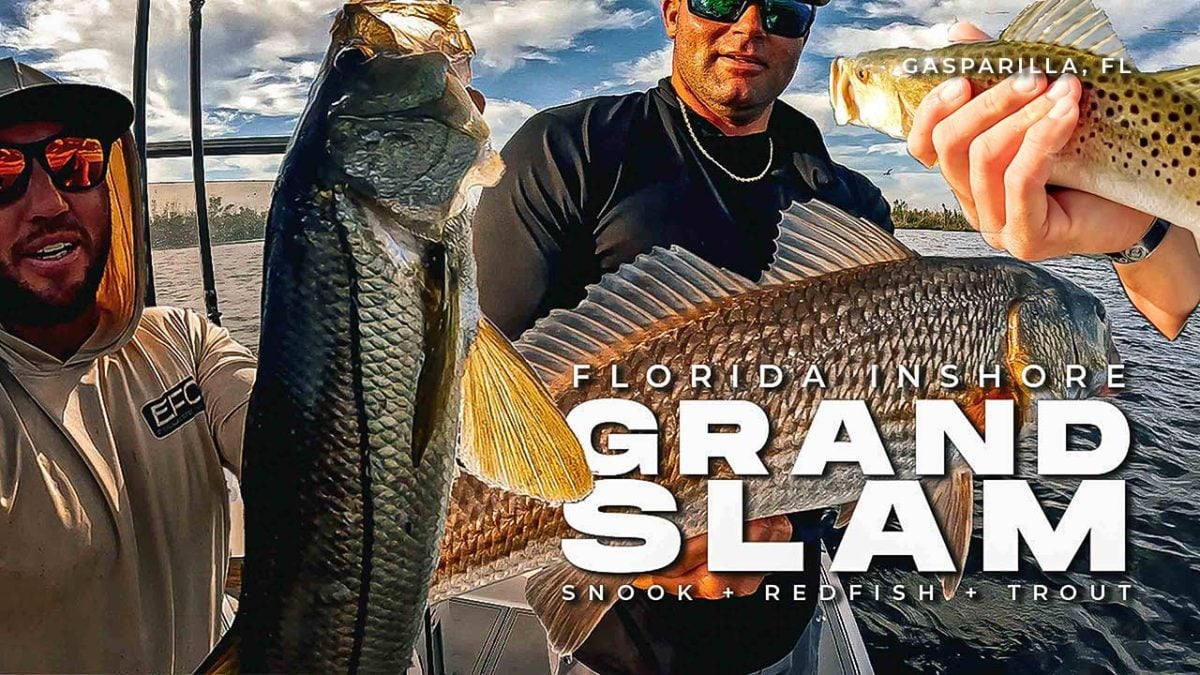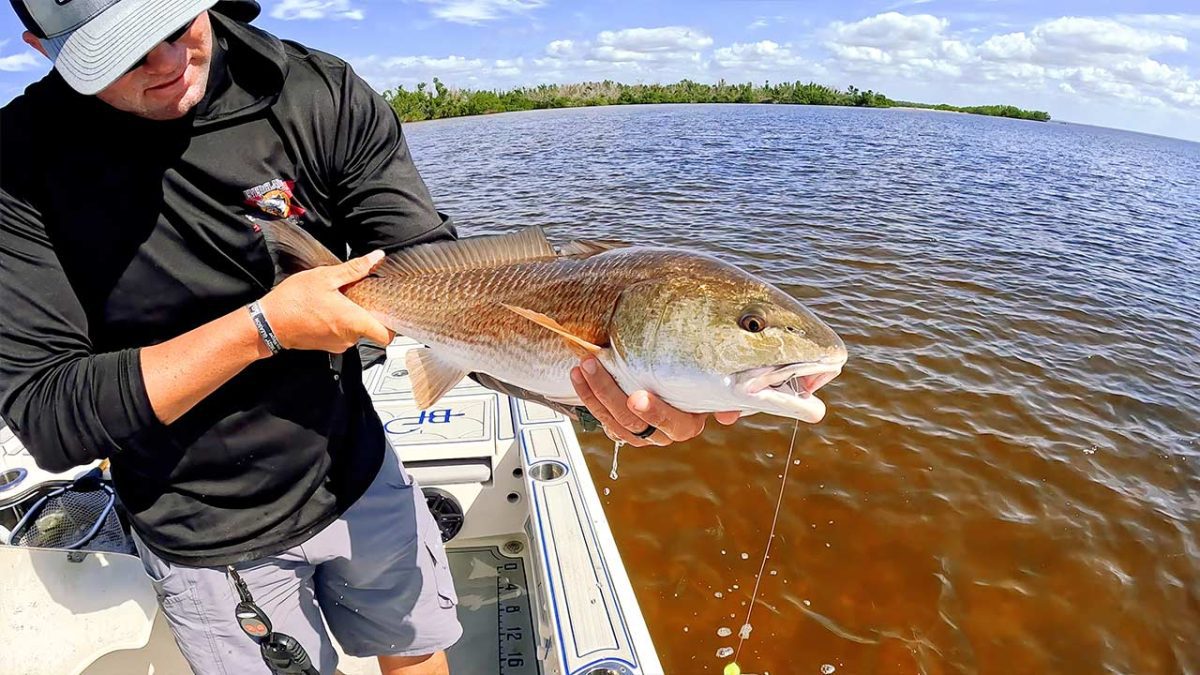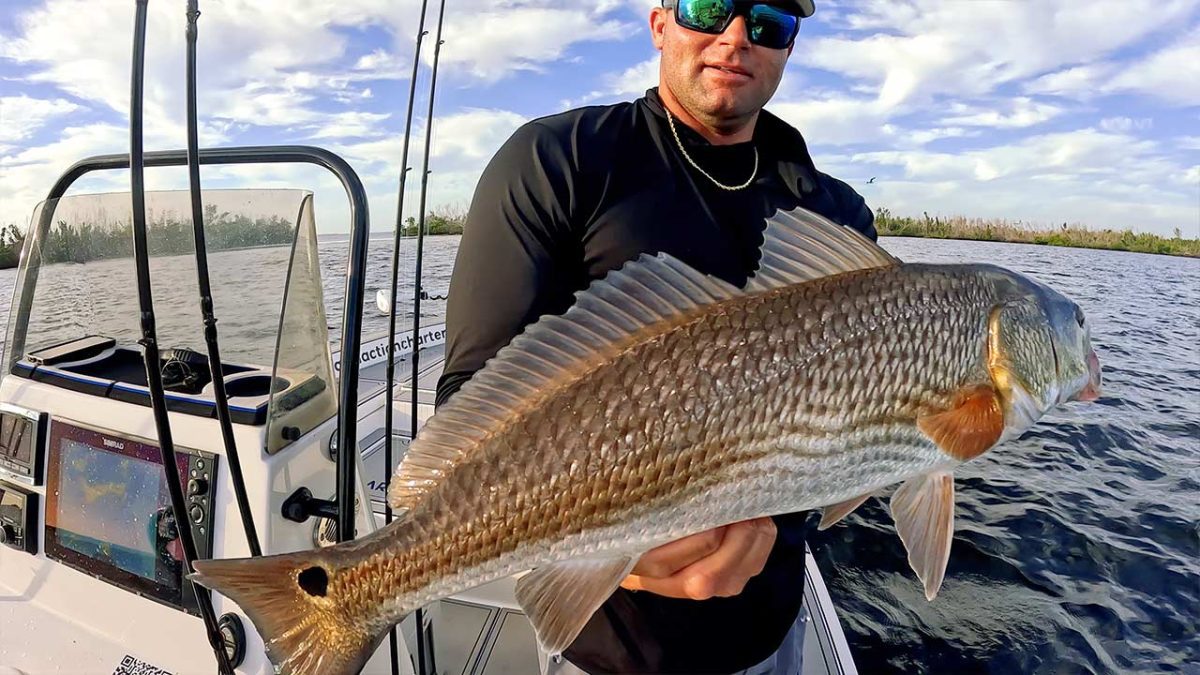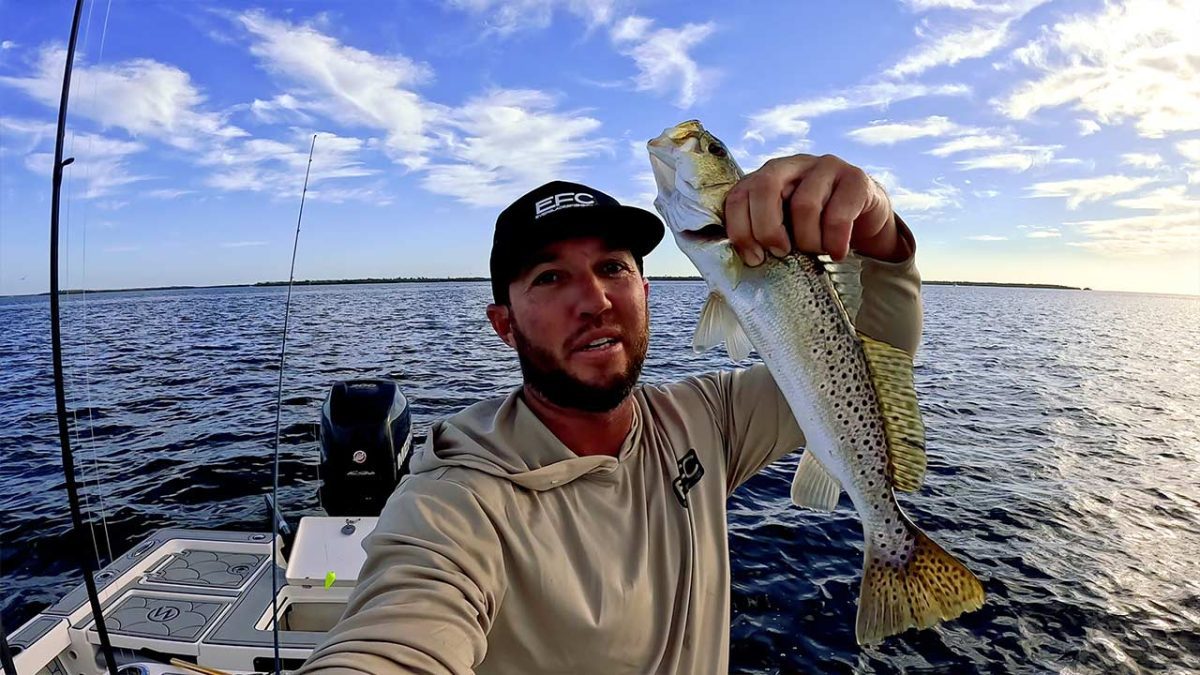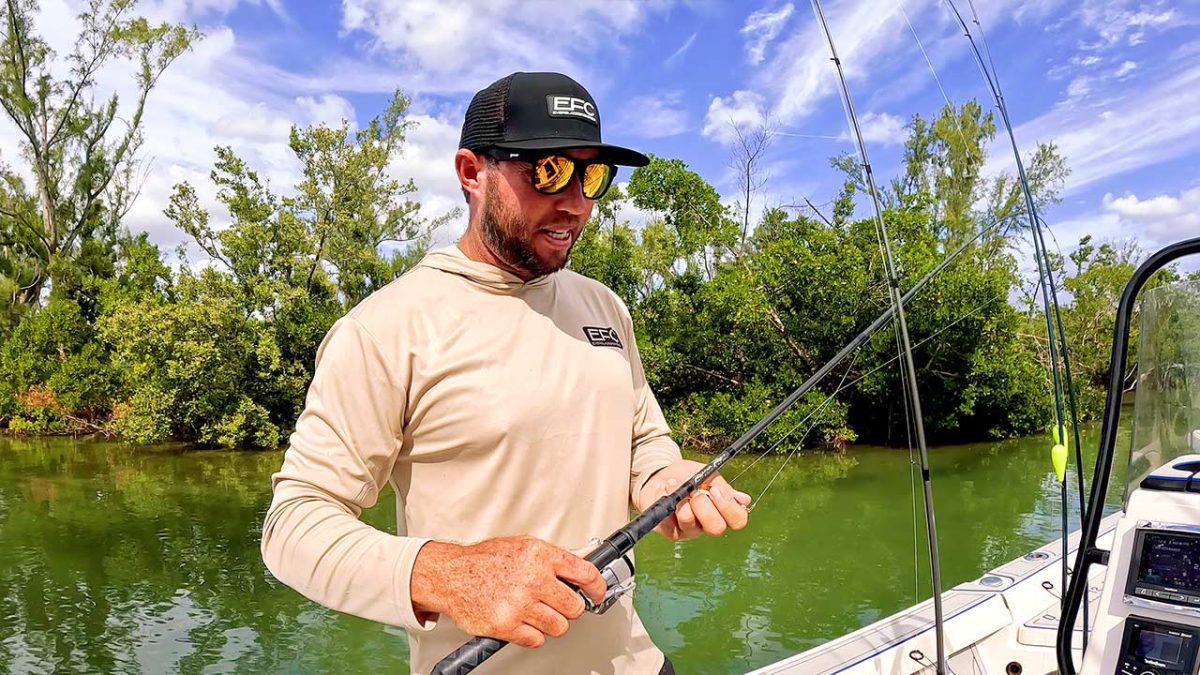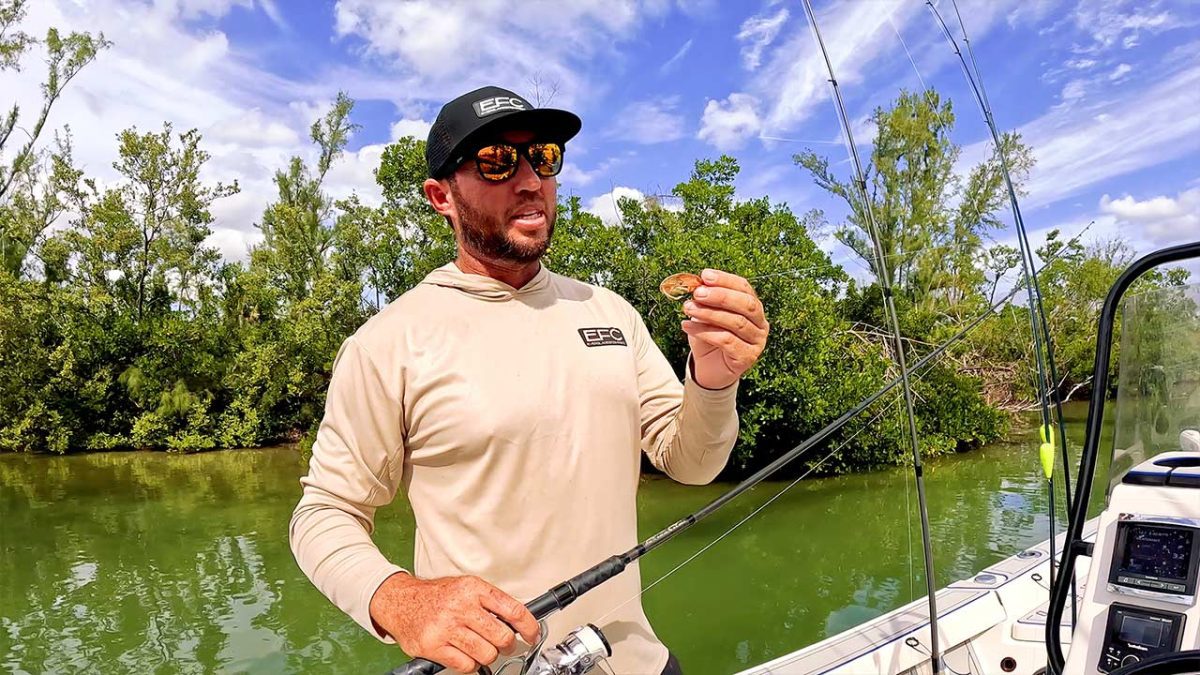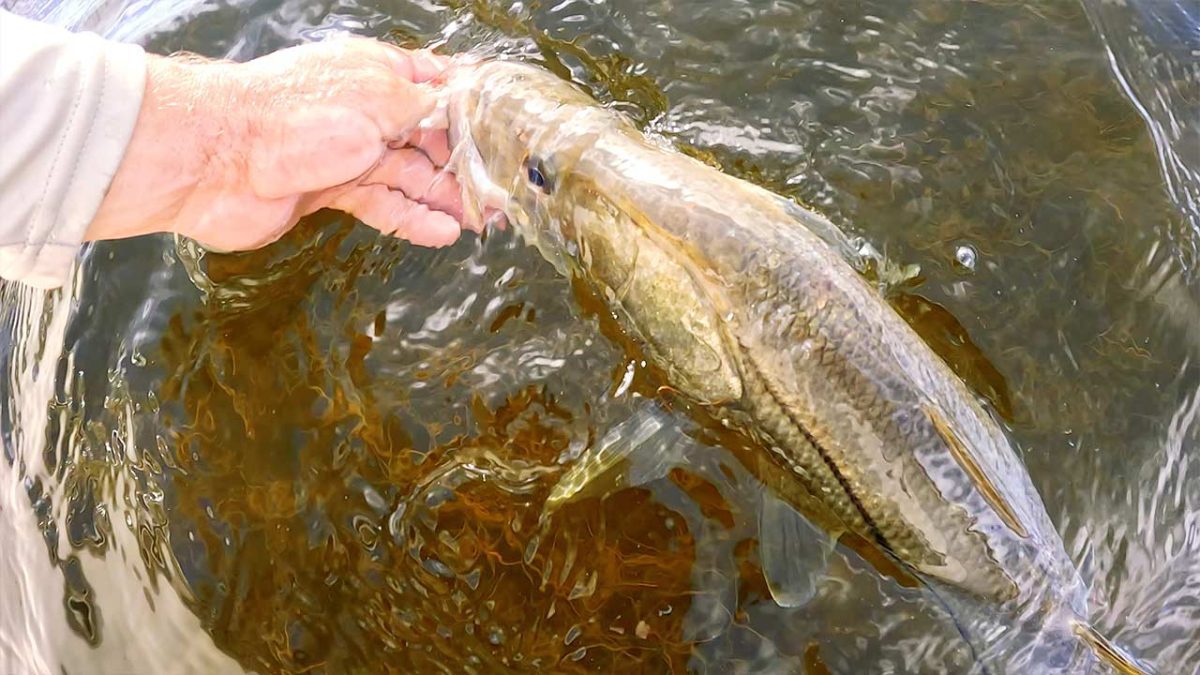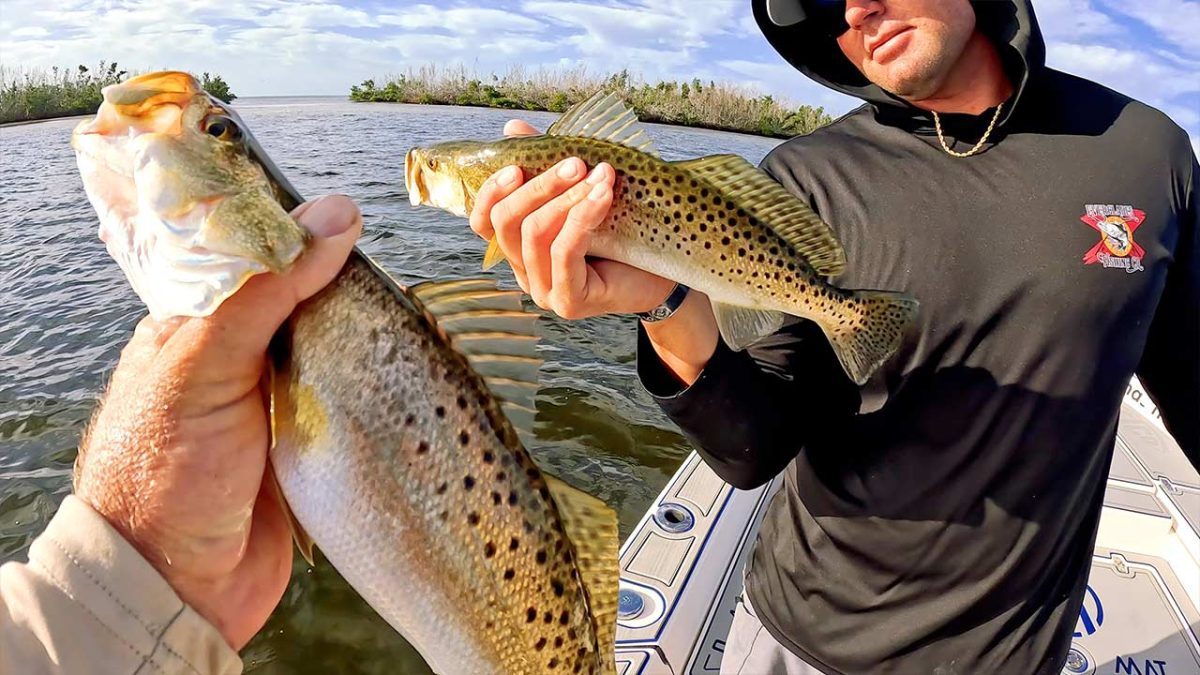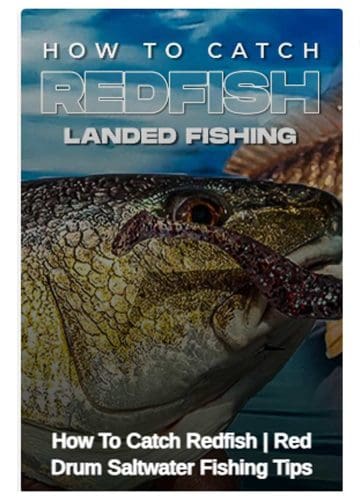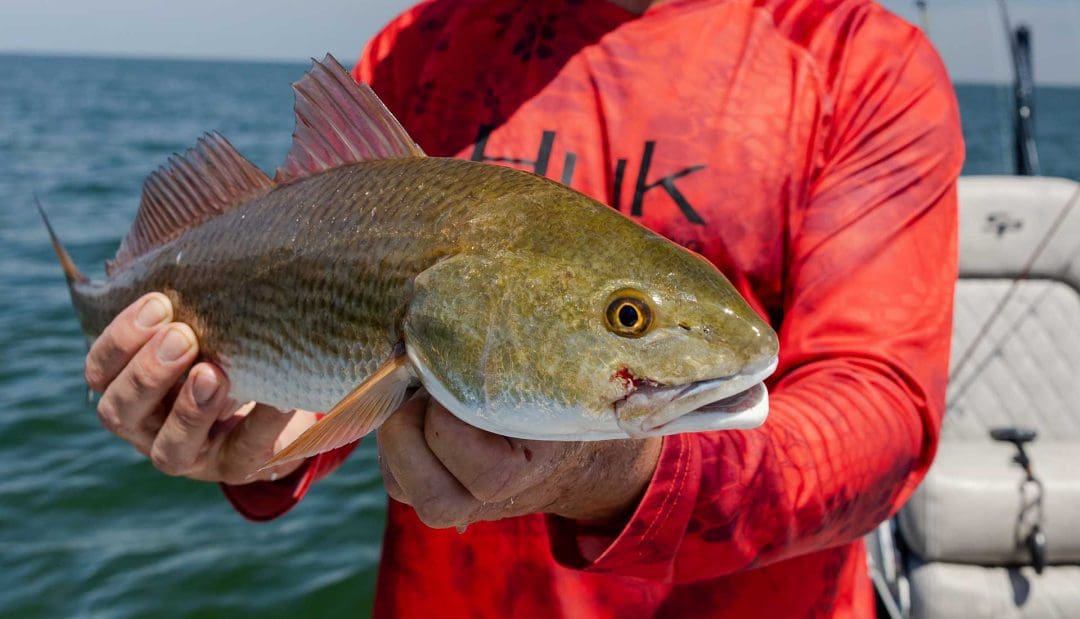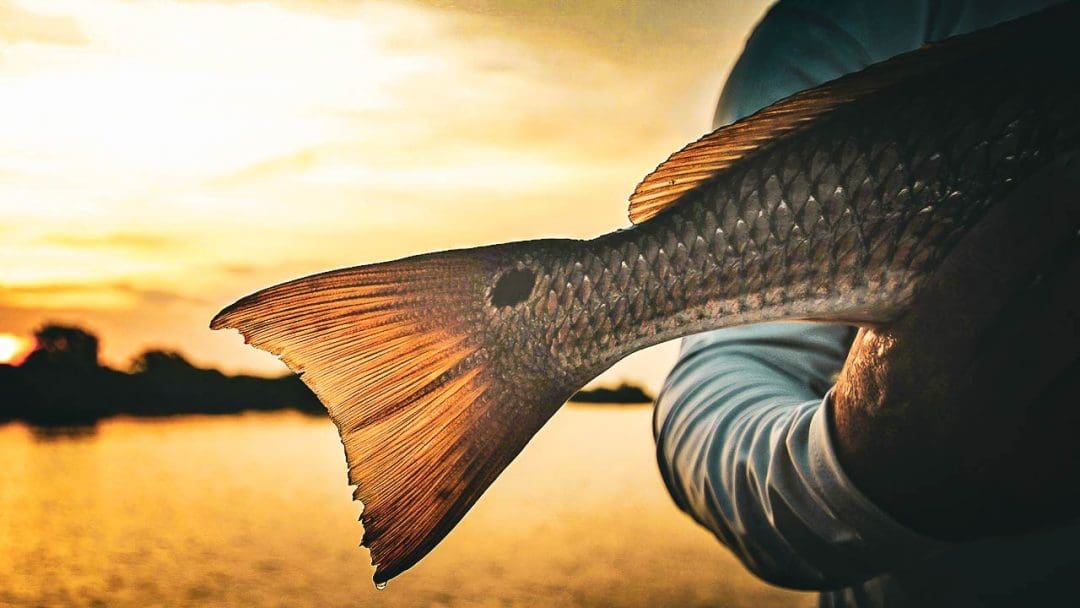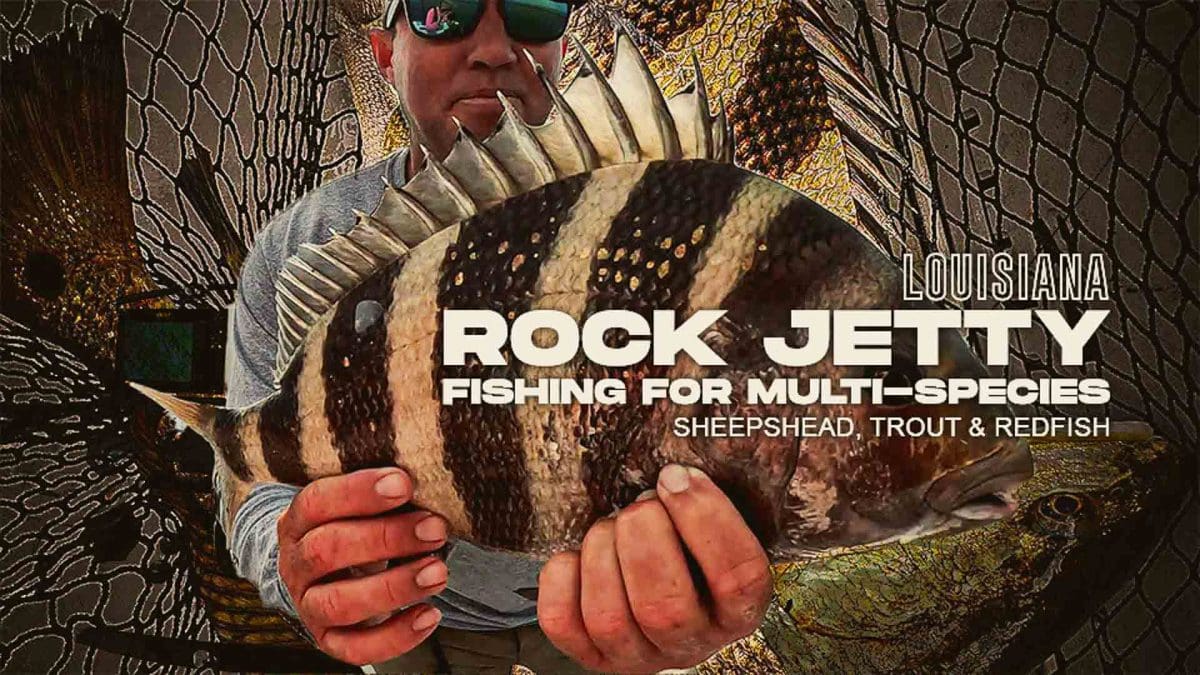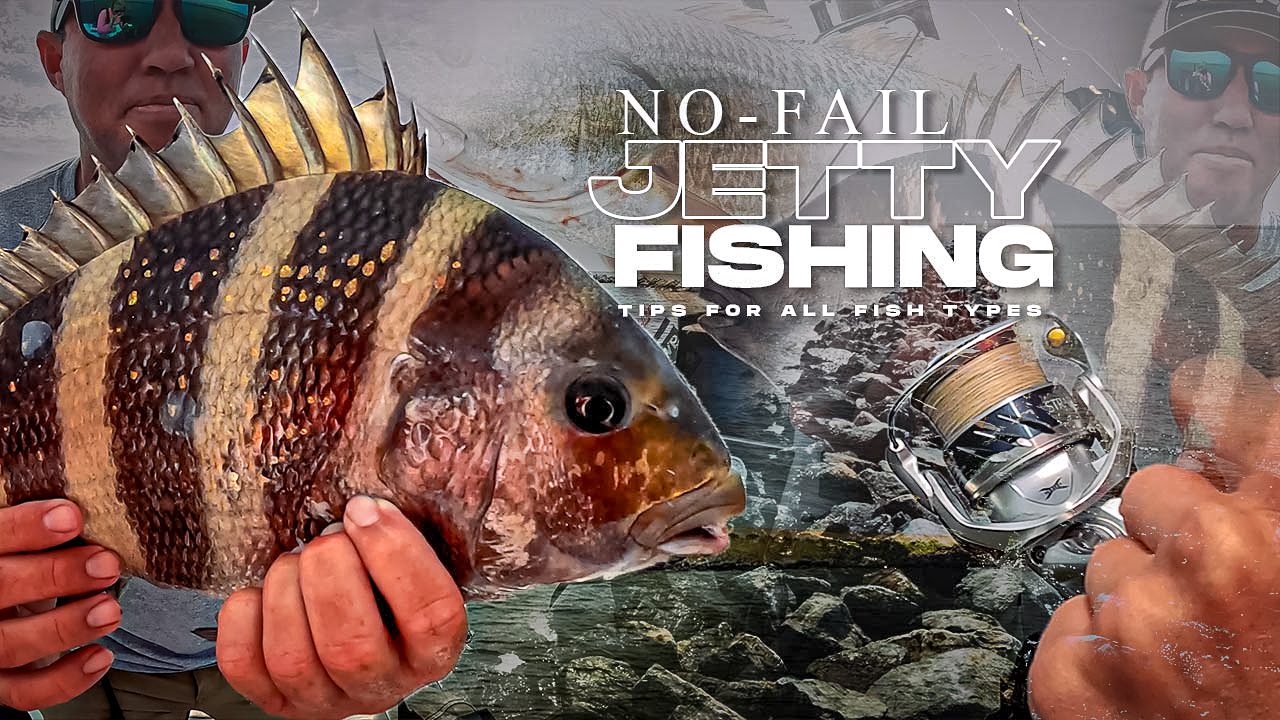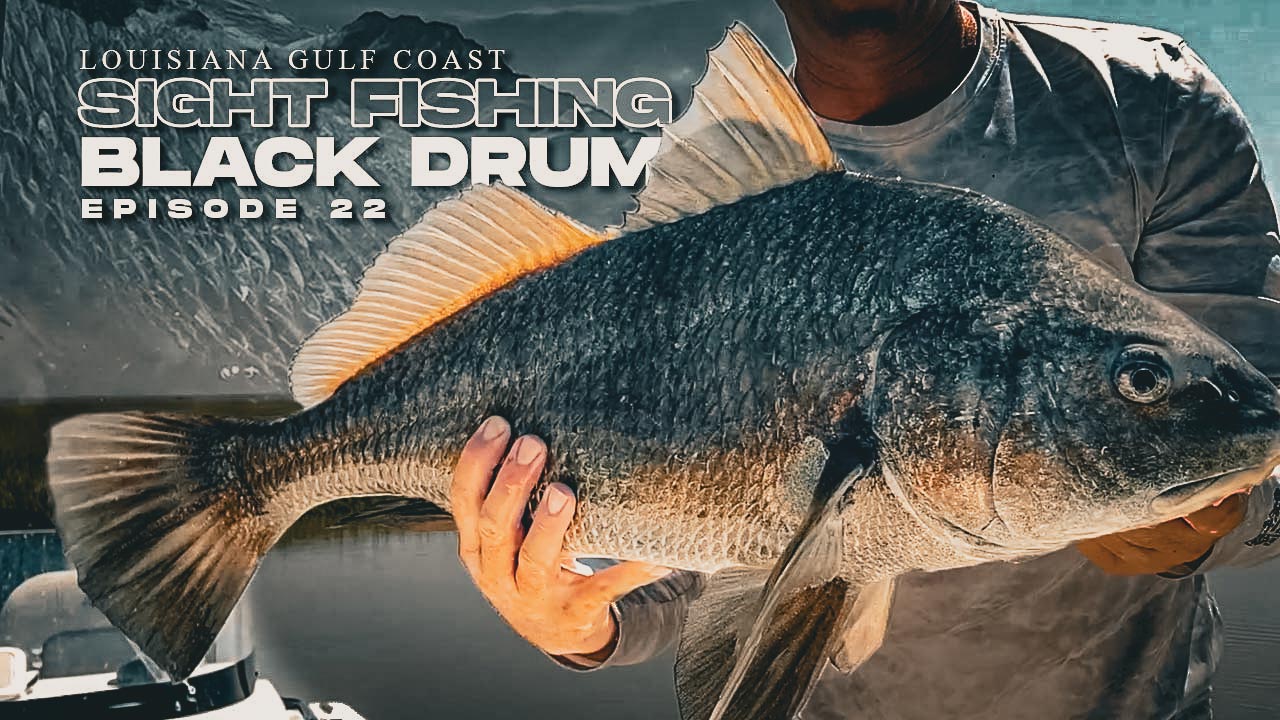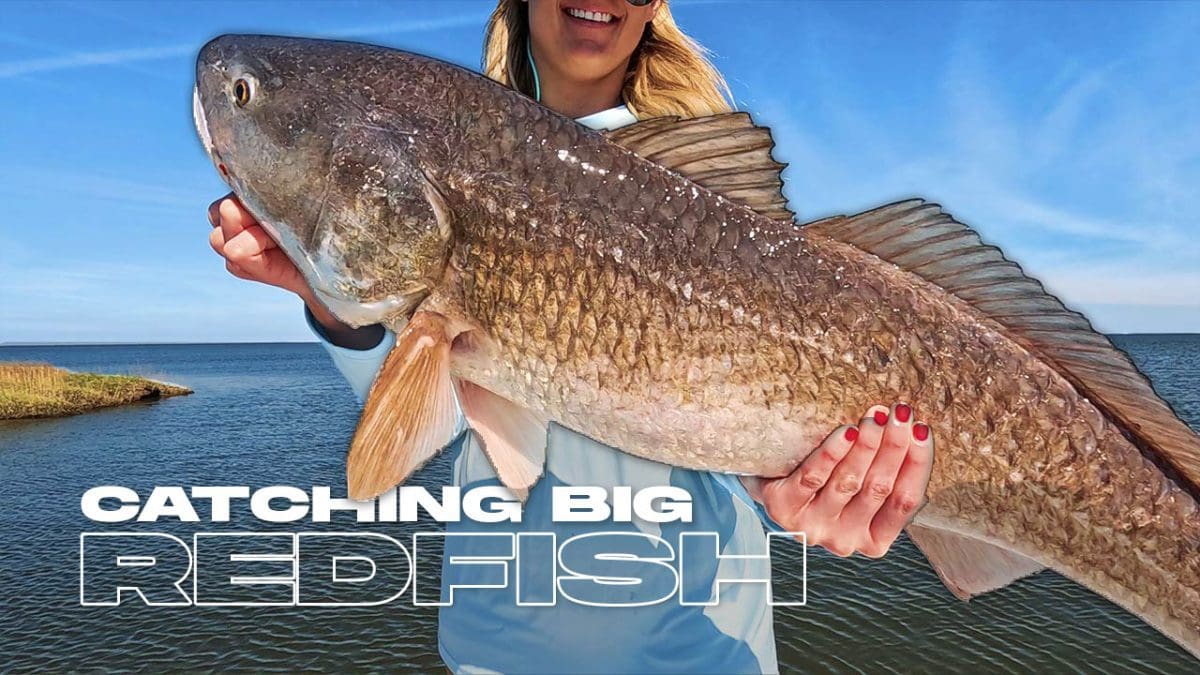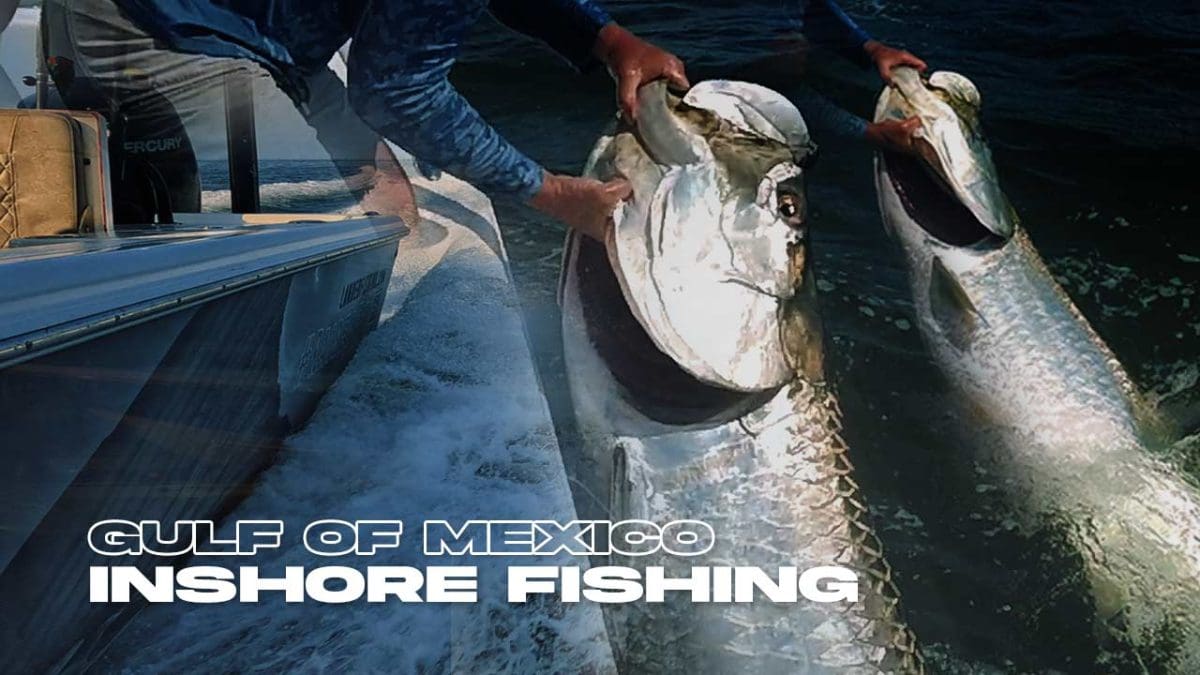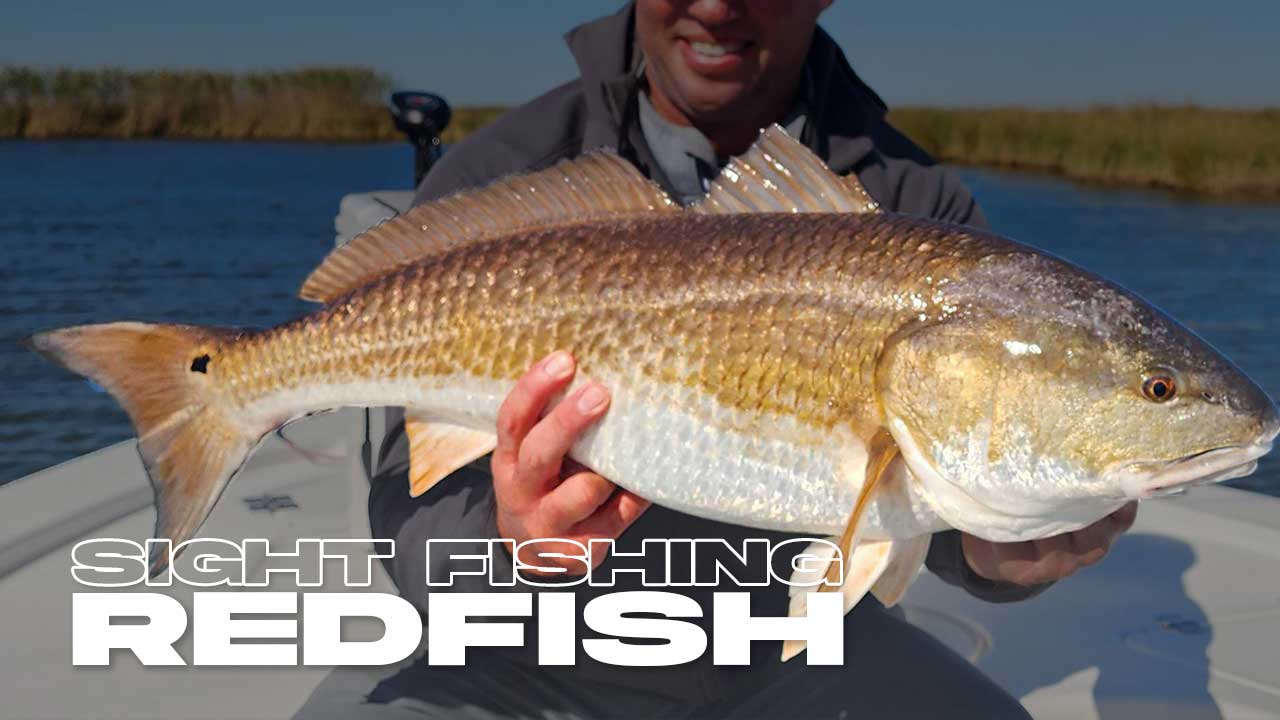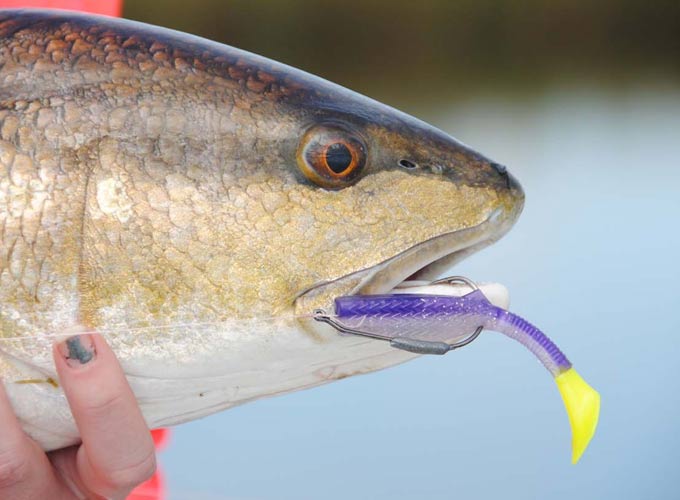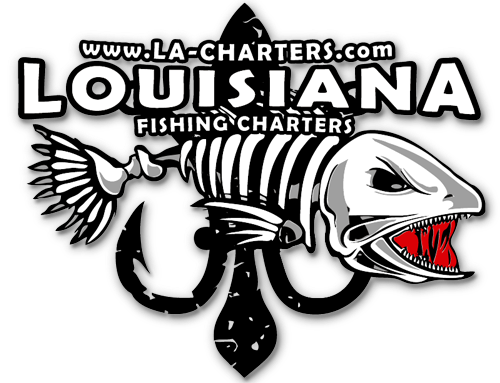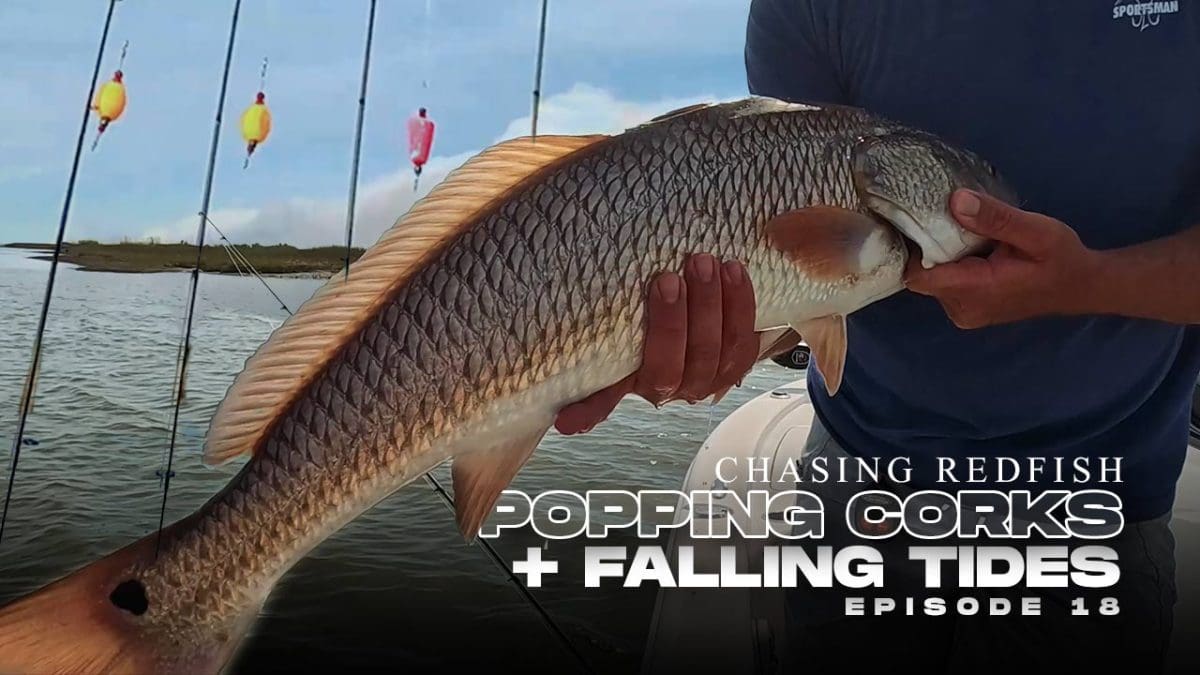How to Catch Redfish in the Gulf of Mexico
Updated:
A Complete Guide for Catching Redfish (Red Drum) in the Gulf of Mexico
Redfish, also known as red drum, are among the most sought-after game fish in the Gulf of Mexico. Their allure isn’t just in their fight but in the versatility they offer to anglers, both novice and seasoned.
But what’s the secret to attracting these coppery bruisers? Let’s dive into the world of redfish and uncover the tactics that make for a successful catch.
Appropriate gear, such as medium-heavy rods and braided line. Learn professional tips on spotting and catching Redfish, the best times to fish for them, as well as factors like water temperature and tidal movements.
How to Catch Redfish
Catching redfish along the Gulf Coast, whether using live or artificial baits, often involves using a variety of effective techniques. Here’s a brief overview of some of the most common baits and methods:
Watch EP44: Catching Inshore Redfish
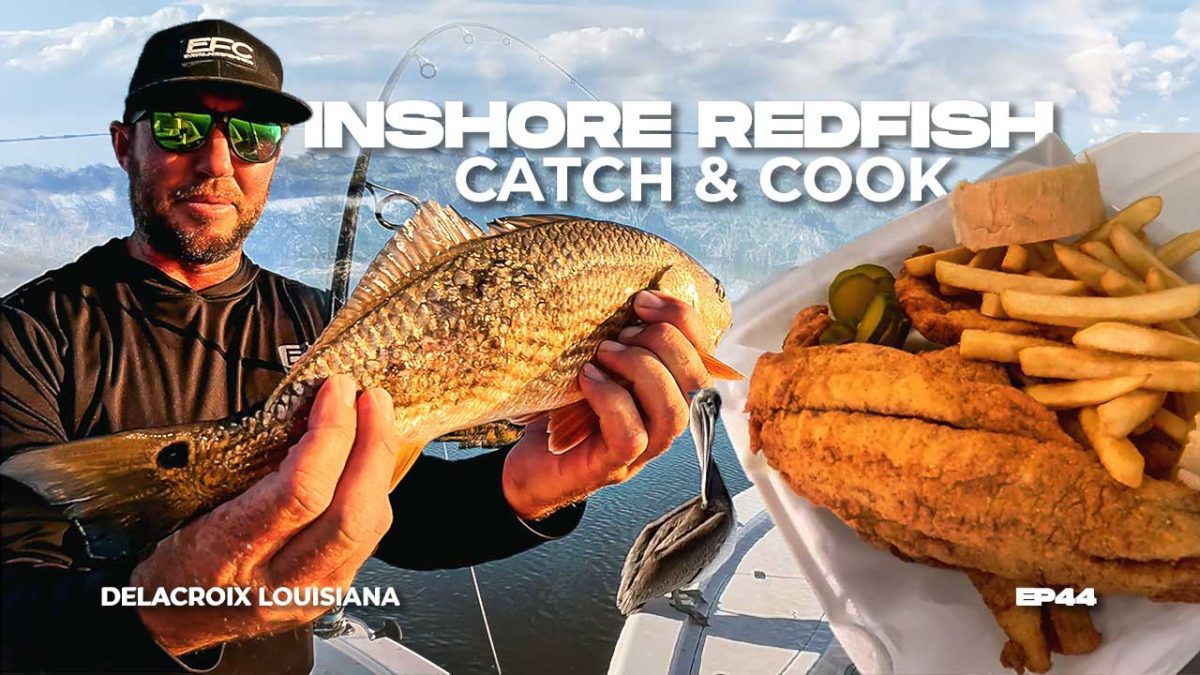
Catching Redfish differs depending on your location around the Gulf of Mexico.
Best Times for Catching Redfish
First up, timing is everything. If you’re looking to catch redfish, spring to fall is your window however Red Drum can be caught year round. As for when you should head out, the early birds and the sunset crowd get the best of the action (in the warmer months), so aim for those early mornings and late afternoons.
The opposite can be said during the cooler winter months, when your best time to catch redfish will actually be at the highest point of the midday sun, keep these in mind when deciding when you should head out for your best chances to catch redfish.
Louisiana Redfish Fishing
Louisiana is renowned for its red drum (Redfish) fishing, with the fish thriving in its coastal marshes, bayous, and shallow coastal waters.
The unique blend of freshwater and saltwater in this region creates an ideal habitat, making red drum a primary target for anglers.
Florida Redfish Fishing
Florida coast redfish inhabit a wide range of coastal environments, including the Atlantic Ocean, Gulf of Mexico, and various bays and lagoons.
While not as abundant as Louisiana, Florida’s saltwater fish diversity allows anglers to pursue Red Drum as well as other species like Grouper, Tarpon and Spotted Seatrout.
The Best Bait for Catching Redfish
Redfish aren’t too fussy with bait, but they do play favorites. Go natural over artificial for better odds, and remember, live bait rules—shrimp and crabs are top picks since they’re redfish fast food. If you’re into lures, pick soft plastics that look and move like these snacks, especially the scented kinds.
Don’t overlook mullet, live or chopped. Big redfish love them for their oily vibe in the water. Whether you’re in the shallows or deep, match your bait to the redfish’s dinner menu for the day, and you’ll up your game.
Best Live Baits for Catching Redfish:
- Shrimp: Live shrimp are a top choice for redfish. They are readily available and can be fished under a popping cork or free-lined.
- Mullet: Finger mullet or larger mullet are natural prey for redfish and can be fished on a Carolina rig or with a float.
- Crabs: Blue crabs or fiddler crabs, when available, can be excellent bait options, especially when targeting larger redfish.
- Pinfish: Pinfish are a common baitfish in the Gulf, and they can be effective when rigged on a hook or used as cut bait.
Best Lures for Catching Redfish
- Soft Plastic Swimbaits: Soft plastic swimbaits in various sizes and colors can mimic the appearance of baitfish and are often rigged on jig heads.
- Jig Heads: Jig heads are versatile and can be paired with various soft plastic baits. Choose a size and weight that matches the water depth and current.
- Spoons: Gold or silver spoons with a fluttering action can attract redfish by creating flash and vibration in the water.
- Topwater Lures: Topwater lures, such as poppers or walk-the-dog style baits, can be exciting when redfish are feeding aggressively near the surface.
Catching Fall Redfish with Dead Bait
Where to find Redfish
Shallow waters are where it’s at. We’re talking grassy spots, oyster beds, docks – these are the redfish’s hangouts. So, that’s where you should be casting your line.
Redfish Habitats
Redfish, also known as red drum, thrive in various habitats ranging from inshore flats to deep offshore waters.
They are most commonly found in estuaries, marshes, and shallow coastal waters where food is abundant.
Identifying these prime locations is crucial for successful redfish angling.
Fishing Gear for Redfish
To target redfish, a medium to medium-heavy spinning or baitcasting rod with a matching reel is ideal.
A 7- to 8-foot medium-heavy rod provides the perfect balance of sensitivity and power needed for these robust fish.
Spool your reel with 15-20 lb braided line for the best combination of strength and casting distance.
Best Live Baits and Lures for Redfish
The Redfish diet includes crustaceans, baitfish, and mollusks. Live bait such as shrimp, mullet, and crabs are highly effective.
When it comes to artificial lures, gold spoons, soft plastic jigs, and topwater plugs can be irresistible to redfish.
Tide and Time: Planning Your Redfish Trip
Tides play a significant role in redfish behavior. Fishing during moving tides, particularly incoming tides, can be incredibly productive as redfish actively feed during these periods.
Dawn and dusk are also prime times to target redfish, as they are most active during lower light conditions.
In addition to time of day, tides play a crucial role in redfish behavior. They tend to feed more aggressively during incoming tides, as the rising waters bring in small fish and crustaceans, offering ample feeding opportunities. Keeping an eye on the tide charts and aligning your fishing efforts with these natural cycles can make all the difference.
Best times to catch Redfish in the Gulf
When Are Redfish Most Active?
Redfish activity levels can vary throughout the day, influenced by tides, weather, and time of year. However, they are generally most active during the cooler parts of the day, such as early morning and late afternoon. During these times, redfish are more likely to be feeding, making them easier to target. Planning your fishing trips around these peak activity periods can significantly increase your chances of a successful outing.
Early Morning and Late Afternoon:
Redfish tend to be more active and feed more aggressively during the early morning and late afternoon when the water temperature is cooler and the light is lower.
This makes these times of day the best for targeting redfish in the Gulf of Mexico.
Incoming Tides:
Incoming tides can bring in fresh prey and nutrients, making them a good time for catching redfish in the Gulf of Mexico.
Look for areas where the tide is moving and cast your line near structures or areas where redfish are known to congregate.
High Tides:
High tides can provide more water for redfish to move into, particularly in shallow areas such as grass flats or marshes.
Look for areas where redfish are known to feed during high tides.
Overcast or Cloudy Days:
Overcast or cloudy days can provide better fishing conditions for redfish in the Gulf of Mexico, as they can be more comfortable and active in these conditions.
Look for areas where redfish are known to congregate.
Redfish Patterns, Tendencies and Behavior
Redfish are also more active during certain times of the day, particularly during the early morning and late afternoon (summer patterns) or mid-day (winter patterns).
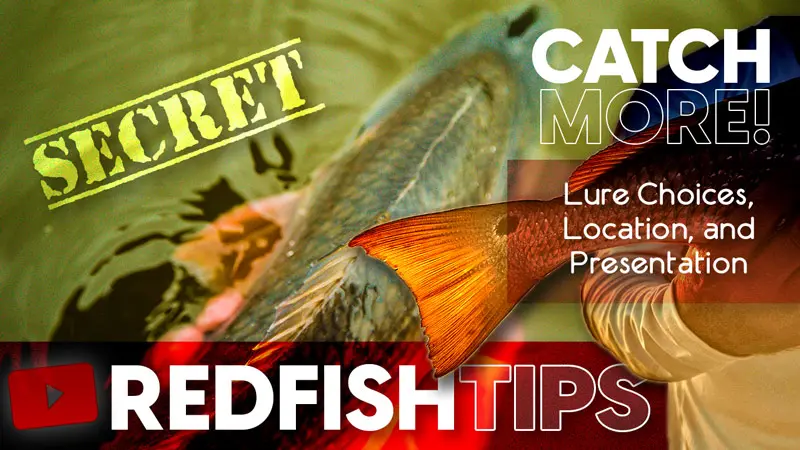
Catching Redfish All Year Long
Catching Winter Redfish
During the winter months, redfish tend to move to deeper waters in the Gulf, where they can find warmer temperatures and a reliable food source. They may also seek out structures such as oil rigs or reefs where they can find shelter and food.
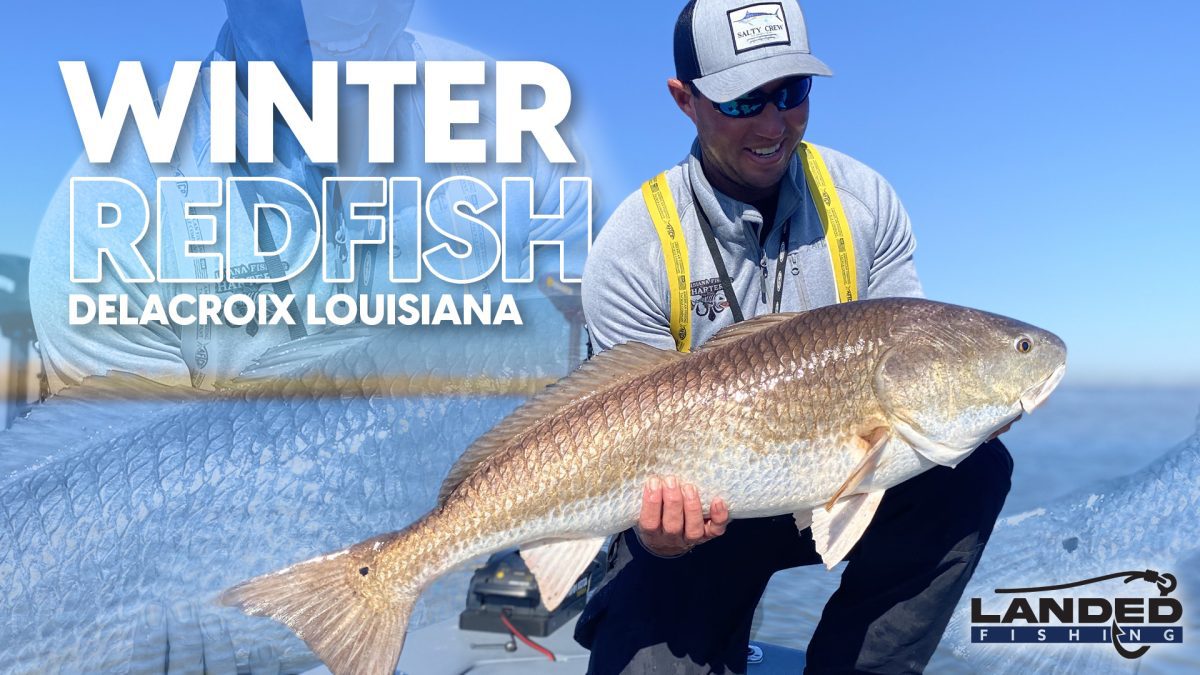
Catching Spring & Early Summer Redfish
In the spring and early summer, as the water temperatures warm up, redfish become more active and begin to move back into the shallower waters of the Gulf’s coastal inshore areas. During this time, Redfish are more likely to be found near grass flats, oyster reefs, and other structures where they can find food and cover.
Catching Fall Redfish
As summer turns to fall, redfish become even more active and are known to school up in large numbers. This makes them easier to target for anglers, as they are more likely to be concentrated in specific areas.
During this time, Redfish tend to feed aggressively in preparation for the colder winter months ahead.
Seasonal behavior of Redfish in the Gulf of Mexico can be key to becoming a successful angler. By targeting the right areas at the right times of year, you can increase your chances of catching these prized game fish.
How-to Spot Redfish
Spotting redfish in the Gulf of Mexico can be challenging but is an important skill for successful Red Drum fishing.
How to spot redfish and where to cast your line for the best results:
As for techniques, think ninja rather than bull in a china shop. Redfish are skittish, so stealth is your best strategy. Approach your fishing spots with care, and cast your bait close to those structures we talked about.
Look for signs of feeding:
One way to spot redfish is to look for signs of feeding, such as surface disturbances or birds diving into the water.
These can be indicators that redfish are feeding on baitfish below the surface.
Look for structures:
Redfish tend to congregate around structures such as oyster reefs, grass flats, and docks.
Look for these structures in the water.
Redfish Bag Limits by US State
| State | Bag Limit | Link to Fish and Wildlife Website |
|---|---|---|
| Alabama | 3 fish per person/day | https://www.outdooralabama.com/fishing/saltwater-fishing |
| Florida | 1 fish per person/day | https://myfwc.com/fishing/saltwater/recreational/red-drum/ |
| Georgia | 5 fish per person/day | https://gadnr.org/fishing-regulations |
| Louisiana | 5 fish per person/day | https://www.wlf.louisiana.gov/fishing/saltwater-rules-regulations |
| Mississippi | 3 fish per person/day | https://www.mdwfp.com/fishing-boating/saltwater-fishing/regulations/ |
| North Carolina | 1 fish per person/day | https://www.ncwildlife.org/Fishing/Laws-Safety/Saltwater-Fishing |
| South Carolina | 3 fish per person/day | https://www.dnr.sc.gov/lawsregs/saltwaterregs.html |
| Texas | 3 fish per person/day | https://tpwd.texas.gov/regulations/outdoor-annual/fishing/ |
| Virginia | 3 fish per person/day | https://www.mrc.virginia.gov/regulations/swrecfishingrules.shtm |
Cast Placement: Coastal Fishing for Redfish and Drum
Positioning for Redfish: Targeting Shallow Water Structure
Redfish and black drum are two of the most sought-after game fish in coastal waters. Both species are known for their hard-fighting nature and delicious flesh, making them popular targets for anglers of all skill levels.
Watch EP24: Cast Placement Redfish & Drum
Catching Redfish and Black Drum
However, catching drum can be challenging, as they are often found in very specific areas and require precise presentation. In this article, we’ll discuss how to position yourself to catch redfish and black drum, with a focus on the different strategies required for each species.

Presenting Bait to Redfish
Approaching Quietly and Anchoring Strategically
Redfish are often found in shallow water, close to the bank. They are known for their preference for areas with structure, such as oyster bars, mangroves, and grass beds.
Choosing the Right Bait or Redfish Lure for Success
Another key to catching redfish is to use the right bait or lure. Live or cut bait, such as shrimp or mullet, is a popular choice, as redfish are opportunistic feeders and will often take whatever is available.
Artificial lures such as soft plastics, spoons, and topwater plugs can also be effective, especially when the fish are active and feeding on the surface.
Positioning to Catch More Fish
When targeting redfish, it is important to position your boat in such a way that you can present your bait or lure as close to the bank as possible, without spooking the fish. This can be challenging, as redfish can be very sensitive to boat noise and movement.
A good strategy is to approach the area slowly, with the trolling motor or push pole, and then anchor or stake out the boat once you are within casting distance of the fish. This will allow you to make accurate casts and keep your bait in the strike zone for longer periods of time.
Positioning for Black Drum: Finding the Right Depth and Current
Black drum, on the other hand, are typically found in deeper water, a boat length from the shore. They are often found around structure such as docks, bridges, and jetties, and can be caught using similar tactics as redfish. However, because they are found in deeper water, it can be more challenging to get your bait or lure in front of them.
One strategy is to use a longer leader and properly sized jig head, which allows you to present your bait near the bottom where black drum are often found. Fishing rigs this way with your weight, leader, and hook, can be used with a variety of baits, including live or cut bait, as well as artificial lures.
Reading the Water: Understanding Your Surroundings While Fishing
As any experienced angler will tell you, understanding the water you’re fishing in is often critical to success. Knowing how to “read” the water can help you identify where fish are likely to be feeding, the best places to cast your line, and the right lures or bait to use.
Let’s explore some key things to look for when reading the water, and provide examples of situations where this skill can come in handy.
Currents and Eddies
Currents and eddies are areas where water is flowing faster or slower than the surrounding water. These areas can be particularly productive for fishing, as they tend to concentrate food and create a natural feeding zone for fish. To identify currents and eddies, look for areas where the water appears to be moving differently than the surrounding water. This might include areas where the water is choppier or where there are visible swirls on the surface.
Rivers or streams, look for areas where the water is flowing over rocks or around bends in the river. These areas are likely to create eddies and currents that fish will be attracted to.
Structure and Cover
Fish are often drawn to areas with structure and cover, such as rocks, logs, or vegetation. These areas provide hiding places for prey and create an ambush point for predators. To identify structure and cover, look for changes in the water depth, such as drop-offs or underwater ledges. You can also look for areas where there is visible vegetation or debris on the surface.
For lakes or ponds, look for areas where there are underwater logs or rocks. These areas can be particularly productive for catching bass or other predator fish.
Water Clarity
The clarity of the water can also affect fishing success. In clear water, fish may be more wary of lures or bait, while in murky water, they may be more likely to strike at anything that appears to be food. To gauge water clarity, look at the water itself, as well as the reflection of the sky or surrounding landscape.
If you’re fishing in a saltwater estuary, pay attention to the clarity of the water. In clear water, you may need to use smaller lures or lighter line to avoid spooking fish.
Looking for Baitfish Activity
Finally, pay attention to the behavior of baitfish in the water. If you see schools of baitfish swimming near the surface or jumping out of the water, it’s a good sign that predator fish are nearby. Look for birds or other wildlife that may be feeding on the same baitfish, as this can indicate a hotspot for fishing.
If you’re fishing in the ocean, look for areas where seabirds are diving into the water. This can indicate a school of baitfish that is attracting predator fish like tuna or mackerel.
The ability to read the water is a key skill for any angler looking to improve their fishing success. By paying attention to currents, and clues the water gives up, you can identify the best places to cast your line and the right lures or bait to use.
Remember, every body of water is different, so take the time to observe and learn the unique characteristics of the water you’re fishing in. With practice and patience, you’ll soon be able to “read” the water like a pro.
Catching Black Drum: Fishing Rigs and Adjusting for Current Flow
When positioning your boat to catch black drum, it is important to pay attention to the tide and current. Black drum often congregate in areas where the current is strong, as it brings food to them. Look for areas where the current is moving quickly, such as around bridge pilings or inlets, and position your boat accordingly.
Once you have anchored or staked out your boat, make sure to adjust your bait or lure presentation to match the current flow. This will help ensure that your bait stays in the strike zone and increases your chances of catching a fish.
Tips for Success: Being Mindful of Habitat and Feeding Patterns for Redfish and Black Drum
Catching redfish and black drum requires a combination of skill, strategy, and patience. By positioning your boat in the right location and using the right bait or lure, you can increase your chances of success.
Whether you prefer to fish shallow waters for redfish or deeper waters for black drum, always remember to be mindful of the fish’s habitat and feeding patterns, and to approach the area quietly and with respect for the fish. With these tips in mind, you’ll be well on your way to catching more redfish and black drum on your next fishing trip.
More Catching Redfish
Gulf Coast Jetty Fishing for Saltwater Fish
Catching Saltwater Fish Along a Rock Jetty
The popping cork and Kahle hook fishing rig is a versatile and effective setup for jetty fishing that can be used to catch a wide variety of fish species.
Get Hooked Up,
Subscribe to Landed Fishing
Our expert guides share tips and techniques, showcasing thrilling catches of popular fish species like redfish, snook, and tarpon.
Enjoy high-quality videos capturing the excitement of the catch and challenges in the Gulf of Mexico.
What is a Jetty?
A jetty is a structure that extends from the shore out into the water, often made of rocks or concrete. Its primary purpose is to protect the shore from erosion. Jetty fishing involves fishing from or along the jetty itself.

Jetties: Habitat and Structure
Jetty habitats can be home to a variety of fish species. They provide shelter and food for fish, as well as a place for them to hide from predators. The rocky surfaces of jetties often provide a habitat for invertebrates such as crabs and shrimp, which can attract larger fish.
Watch Video: Jetty Fishing Gulf Coast
Currents and Water Flow around a Jetty
The structure of a jetty can have an impact on water flow and can create currents and eddies that can affect fishing conditions. As water flows around the jetty, it can create areas of turbulence and changes in water depth, which can create a variety of fishing opportunities.
The water flow around the jetty can also have an impact on the behavior of fish. Some fish species, such as redfish, may be attracted to areas of high water flow, while others, such as trout, may prefer slower-moving water. Understanding how water flow affects fishing conditions can be key to successful jetty fishing.
It’s important to note that fishing from a jetty can also present certain risks, such as slippery surfaces and strong currents. It’s important to take appropriate safety precautions, when fishing in and around a rock jetty.
How to fish a Rock Jetty
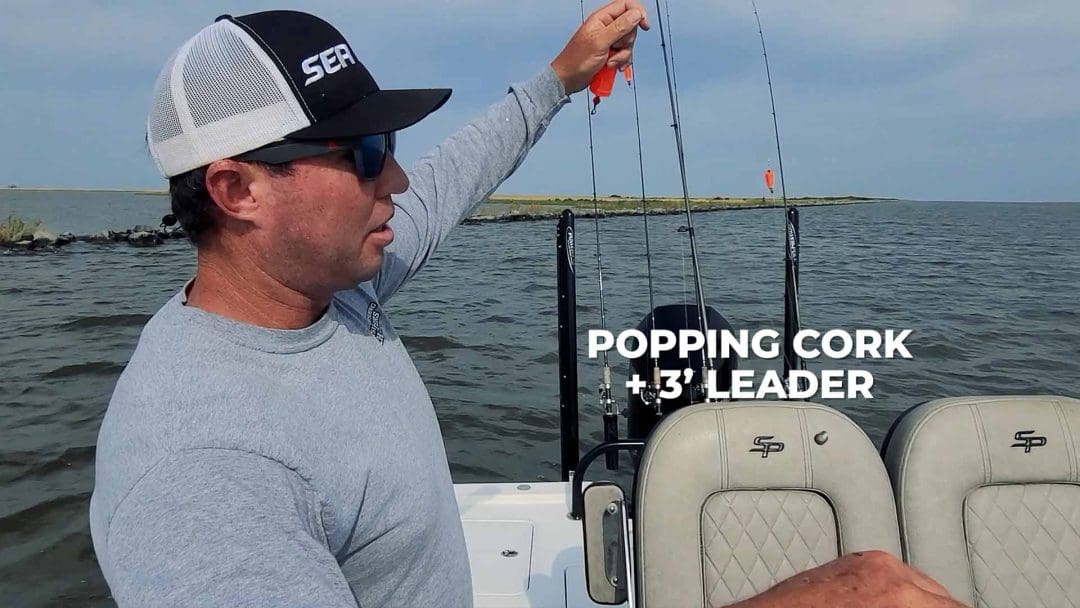
If you’re fishing from shore, such as wearing appropriate footwear and being aware of weather and water conditions, and if you’re in a boat, keep the vessel a safe distance to avoid grounding on sub surface rocks and obstructions.
Popping Cork and Kahle Hook Rig for All Fish Types

The rig consists of a popping cork, which is a buoyant float with a concave top that creates a popping sound when jerked, and a Kahle hook, which is a type of fishing hook that helps to prevent snagging on underwater debris.
To set up the rig, attach the popping cork to the main line using a swivel, and tie a leader line with the Kahle hook to the other end of the cork. Add bait or a soft plastic lure to the Kahle hook, and cast the rig out near the jetty.
The popping cork attracts fish by mimicking the sound of baitfish popping at the surface, while the Kahle hook allows for a more snag-less presentation of the bait or lure, reducing the chances of getting stuck on the rocks and increasing the chances of a bite.
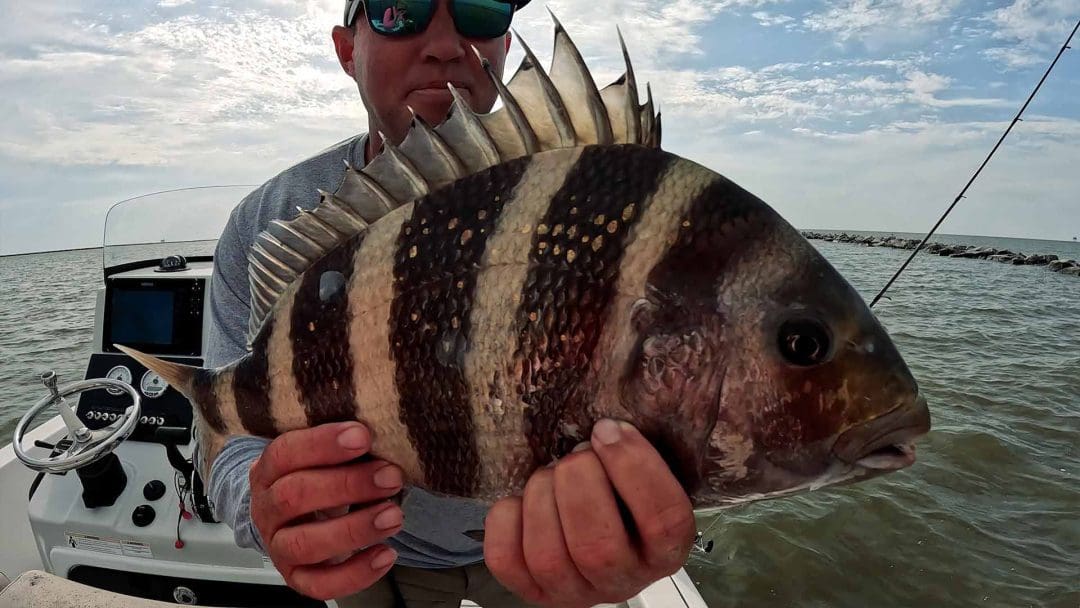
What type of fish can it catch
This rig can be effective for catching a variety of fish species, including redfish, sheepshead, drum, trout, flounder, snook, and more.
Reliable and Versatile Jetty Fishing Rig
Popping cork and kahle rig is especially useful in areas with underwater structure or vegetation, such as jetties, docks, and bridges. The popping cork and Kahle hook rig is a reliable and versatile setup that can increase your chances of success while jetty fishing for all types of fish.
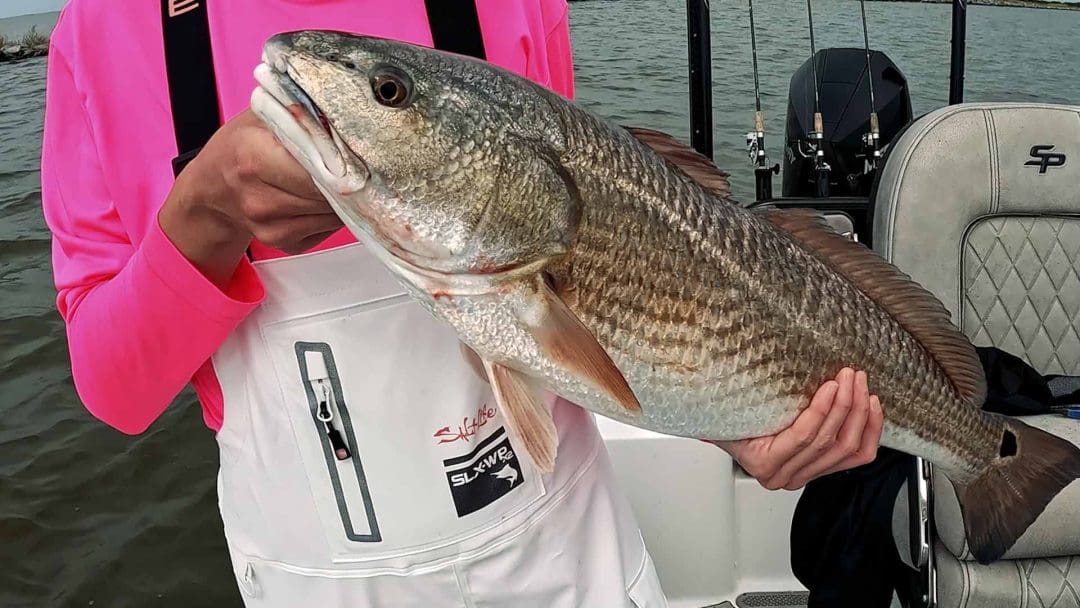
Jetty Fishing FAQs
Sight Fishing Black Drum: Gulf Coast
Sight Fishing for Black Drum:
Black drum is a species of fish found in the Gulf of Mexico and along the Gulf Coast. They are typically gray or black in color and can weigh up to 90 pounds. Black drum are known for their powerful, bottom-dwelling abilities, making them a challenging catch for anglers.
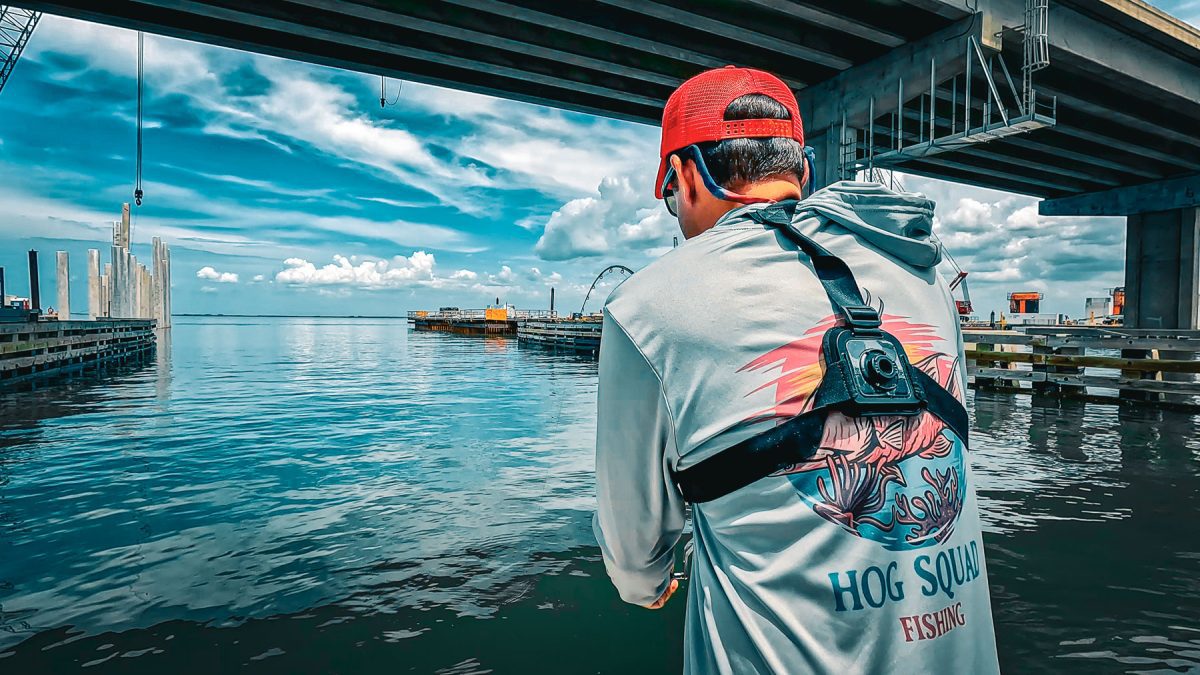
Watch Video: Sight Fishing Black Drum
Where to Find Black Drum in the Gulf of Mexico
To increase your chances of catching black drum, it’s important to know where to find them. They are typically found in shallow water near structures like jetties, bridges, and oyster reefs. Look for areas with a mix of sand and mud bottoms, as these provide ideal feeding grounds for black drum.
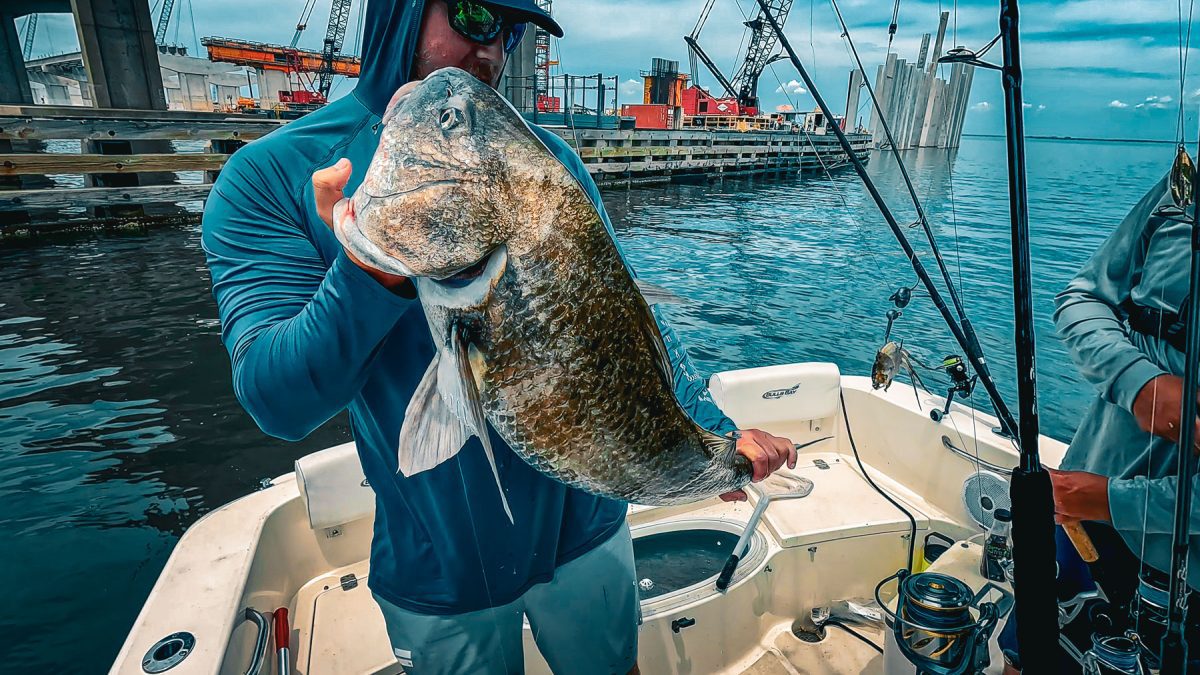
Bag Limits for Black Drum
| Gulf Coast State | Black Drum Bag Limit |
|---|---|
| Texas | 5 fish per day, 14-inch minimum size limit |
| Louisiana | 10 fish per day, 16- to 27-inch slot limit |
| Mississippi | 3 fish per day, 14- to 24-inch slot limit |
| Alabama | 10 fish per day, 16- to 26-inch slot limit |
| Florida | 5 fish per day, 14- to 24-inch slot limit |

Equipment for Sight Fishing Black Drum
To successfully sight fish for black drum, you will need the right equipment. A medium-heavy spinning rod with a fast action tip is a good choice, paired with a spinning reel loaded with 20-30 lb test braided line. A fluorocarbon leader is recommended to increase your chances of a bite.
Lure Selection for Sight Fishing Black Drum
The right lure selection is critical for sight fishing black drum. Soft plastic baits like curly tail grubs and shrimp imitations work well, as do topwater lures like poppers and walk-the-dog style baits. Experiment with different colors and sizes until you find what works best for you.
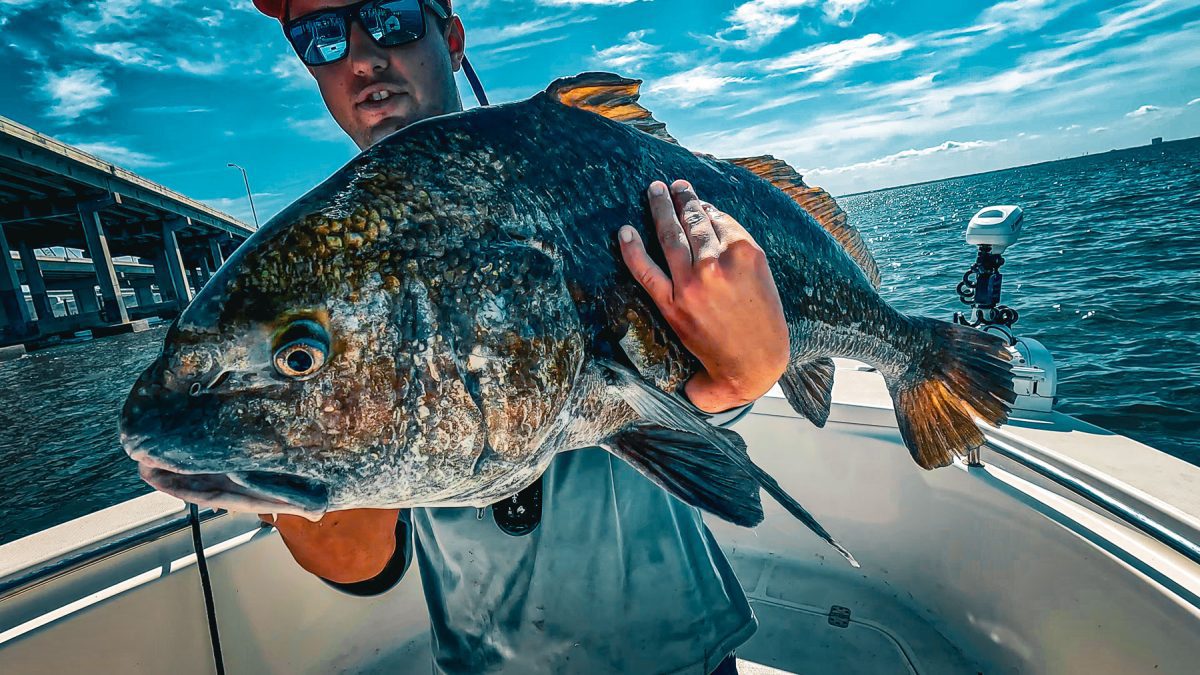
Sight Fishing Techniques for Black Drum
When sight fishing for black drum, it’s important to be patient and observant. Look for signs of feeding activity, like tails or swirls on the surface of the water. Slowly approach the fish and make a cast past them, reeling your bait back towards them. Make sure to keep your line tight and be ready for a strike at any moment.
Tips for Optimizing Your Sight Fishing Experience
To increase your chances of success when sight fishing for black drum, there are a few tips to keep in mind. Firstly, try to avoid making loud noises or sudden movements that could spook the fish. Secondly, pay attention to the tide and time of day, as black drum tend to feed more actively during certain times. Finally, be prepared to adjust your tactics as necessary to adapt to changing conditions.
Sight fishing for black drum is an exciting and challenging experience for anglers of all levels.
With the right equipment, lure selection, and techniques, you can increase your chances of a successful catch. Remember to be patient and observant, and always be willing to adapt your approach as needed to optimize your sight fishing experience.
Explore More
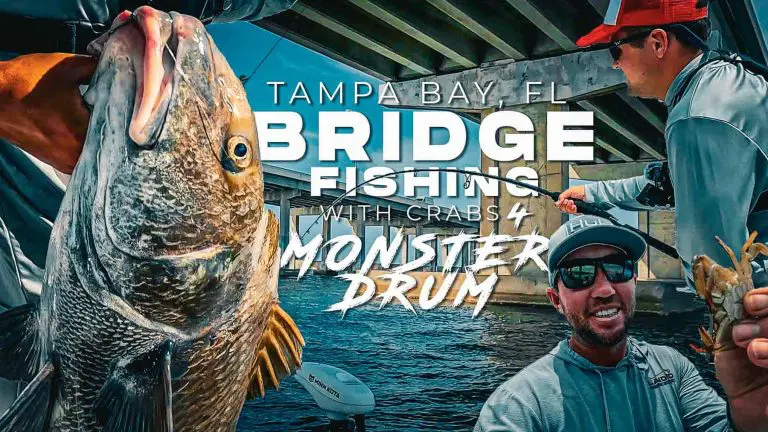
Tampa Bridge Fishing using Crab for Monster Fish Join the crew with Hog Squad Fishing and Tsunami Tackle as…
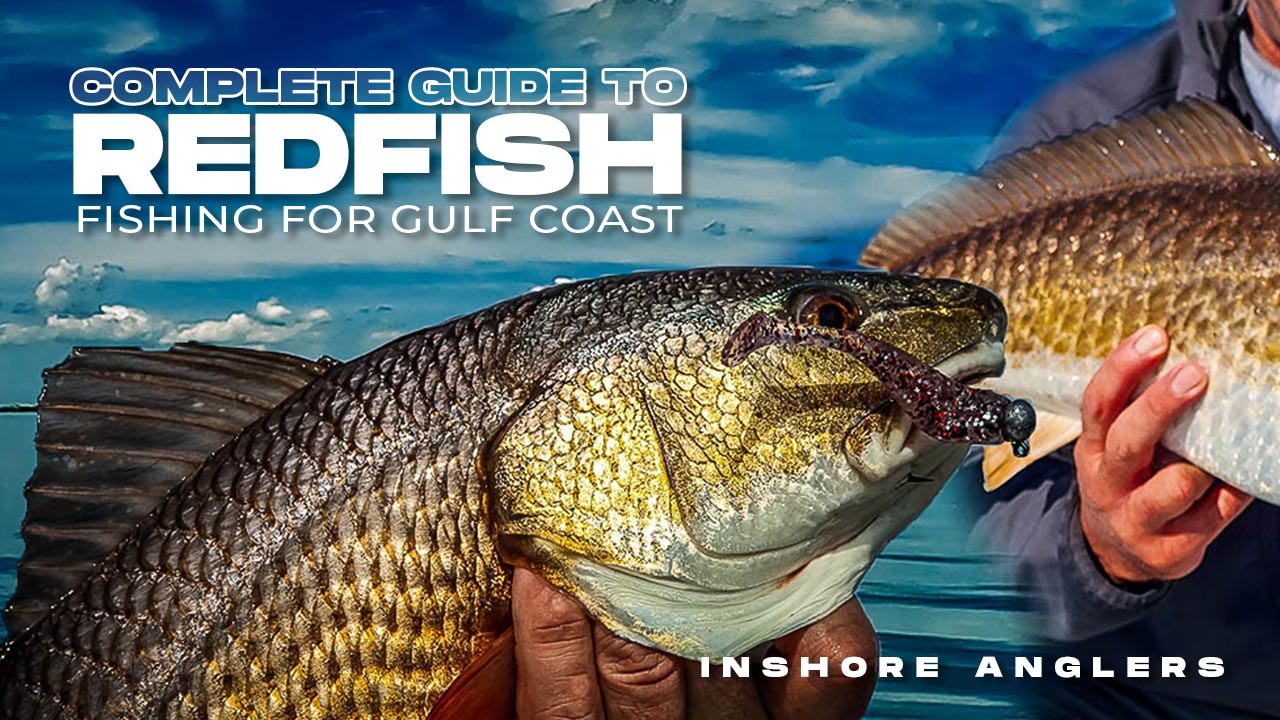
Fishing Guide: Catching Redfish in the Gulf of Mexico Learn How to Catch Redfish (Red Drum) in the Gulf…
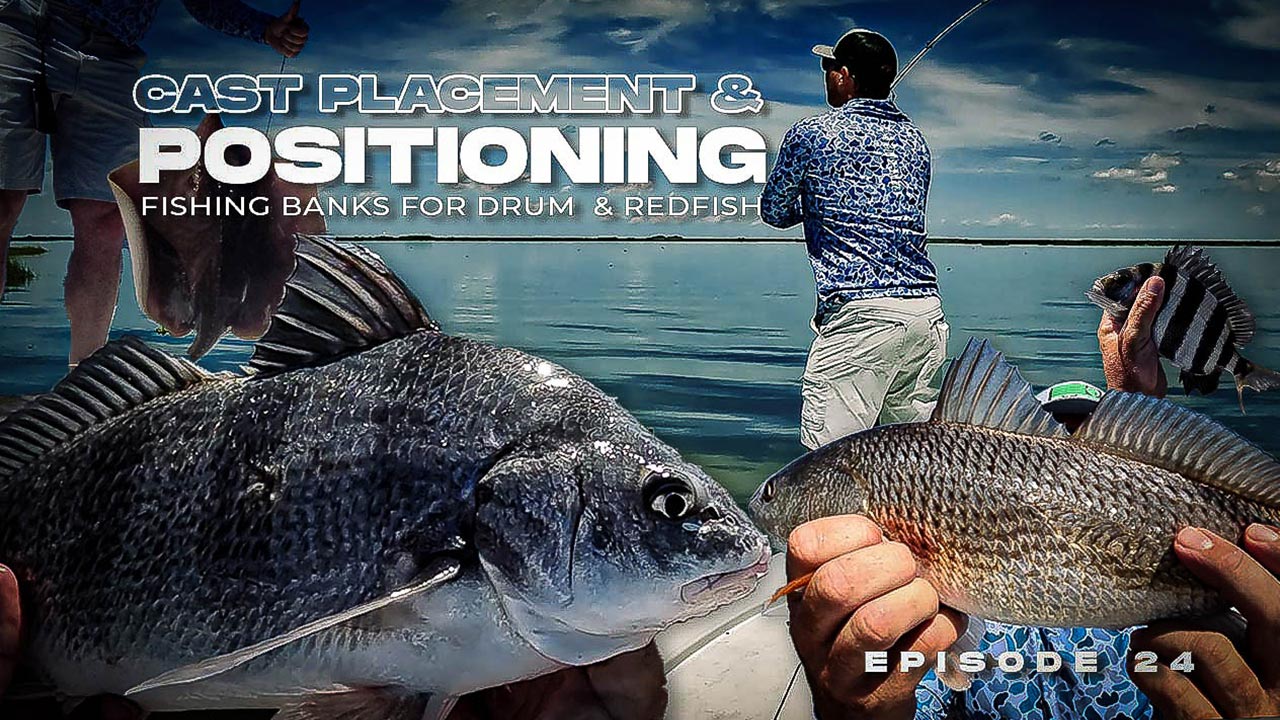
Cast Placement | Bank Fishing Redfish & Black Drum Positioning to Catch More Fish. Learn about effective positioning when…
Sight Fishing Black Drum
Blackened Redfish Recipe: Catch Clean Cook
Blackened Redfish: Catch, Clean & Cook
Join Landed Fishing as we explore Louisiana’s coastal inshore waters in search of the perfect catch. Watch as we hook and reel in the prized Blackened Redfish, before taking you through the process of cleaning and cooking this delicious delicacy.
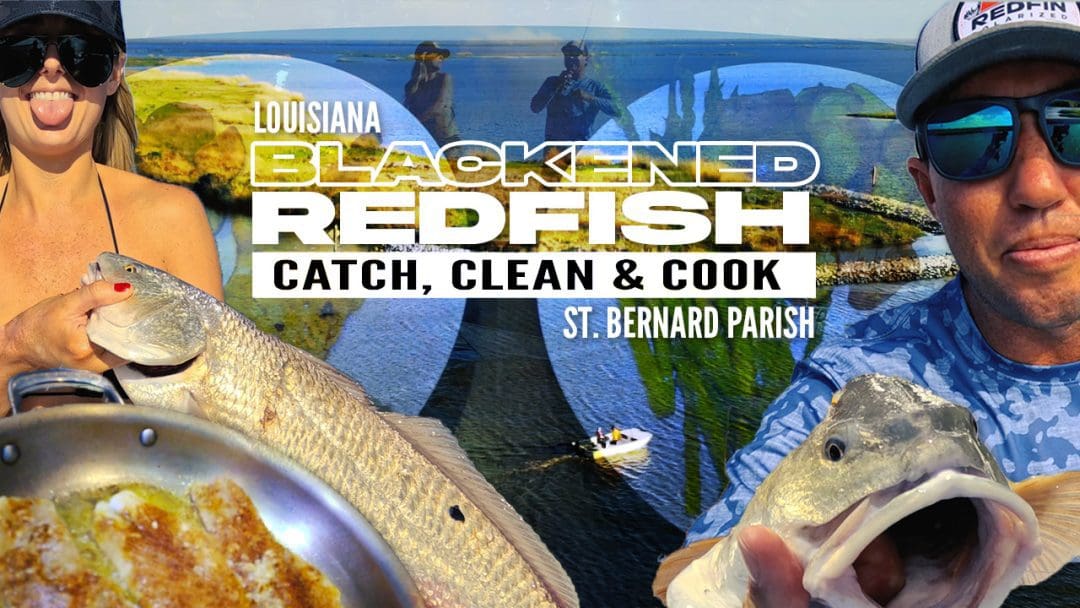
Blackened Redfish: Catch & Cook
Catching and cooking blackened redfish can be a delightful experience, guaranteeing a fresher and better-tasting meal with a few simple steps.
When fishing, opting for live bait or fresh-cut bait to attract redfish more effectively.
Once caught, clean and fillet the fish, removing any dark meat for a milder taste. For cooking, use high-quality blackening seasoning, or prepare your own mix with a blend of herbs and spices to enhance the flavor.
Preheat the skillet or grill to a high temperature to achieve a perfect sear and create a delicious crust on the fish. Remember not to overcook the redfish; it’s best when still moist and tender inside.
With our expert tips and tricks, you’ll be able to recreate this Cajun-style dish in your own kitchen.
Don’t miss out on this exciting fishing adventure, right here and on our YouTube channel.
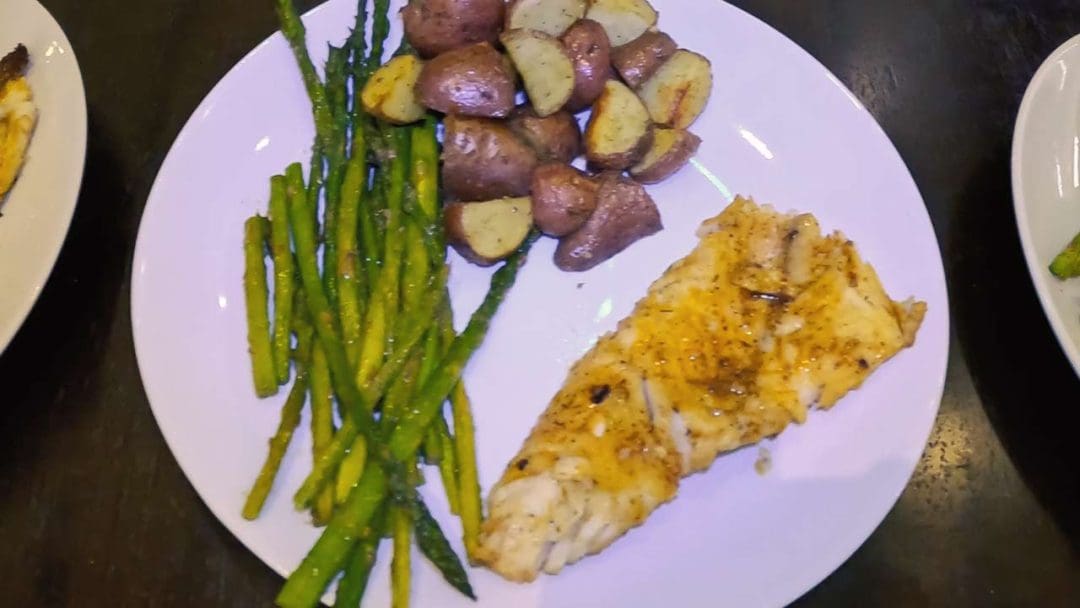
Watch Episode 21: Blackened Redfish (Catch & Cook)
Fishing for redfish is thrilling, and preparing blackened redfish is an enjoyable culinary adventure, from catching to cooking.
The reward is a delicious, flavorful meal to share with loved ones by the water.
With our easy-to-follow cooking instructions, you’ll be able to whip up a delicious Cajun-style dish in no time.
Cajun Blackened Redfish Recipe
Light – Blackened Redfish Recipe
A simple and lighter blackened redfish recipe option using butter, garlic, and Prudhomme’s Redfish Magic seasoning (link to buy on AMZN):
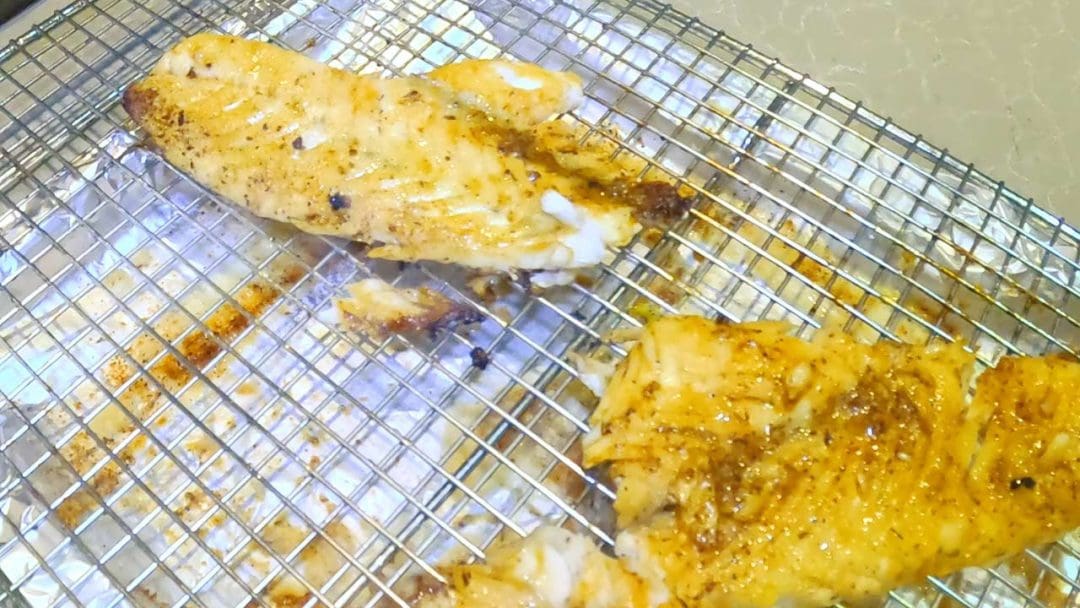
Blackened Redfish Ingredients:
Easy Redfish Recipe with a skillet
2 redfish fillets, about 1 inch thick
2 tablespoons unsalted butter
2 tablespoons garlic, minced
2 teaspoons (or as desired) Prudhomme’s Redfish Magic seasoning
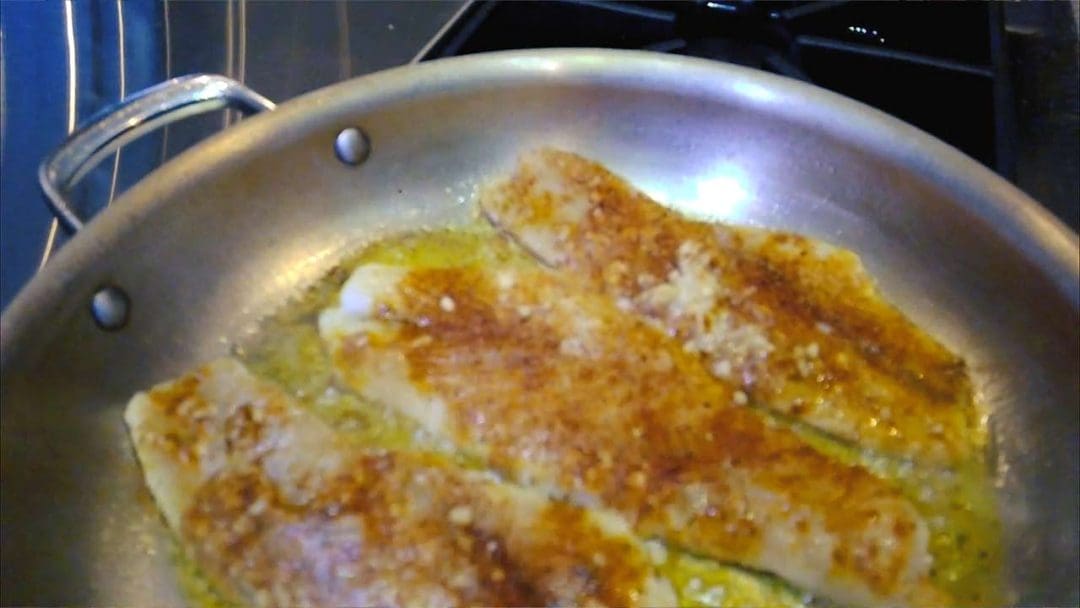
Redfish Cooking Instructions:
Redfish Recipes: Skillet

Preheat a non-stick skillet over high heat for about 5 minutes.
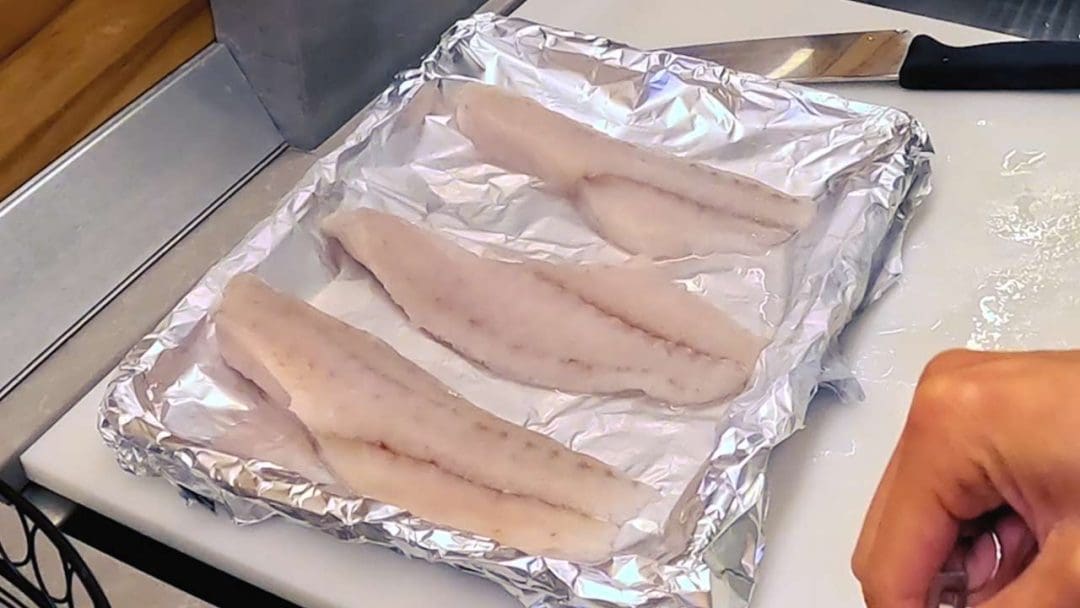
While the skillet is heating up, pat the redfish fillets dry with a paper towel.
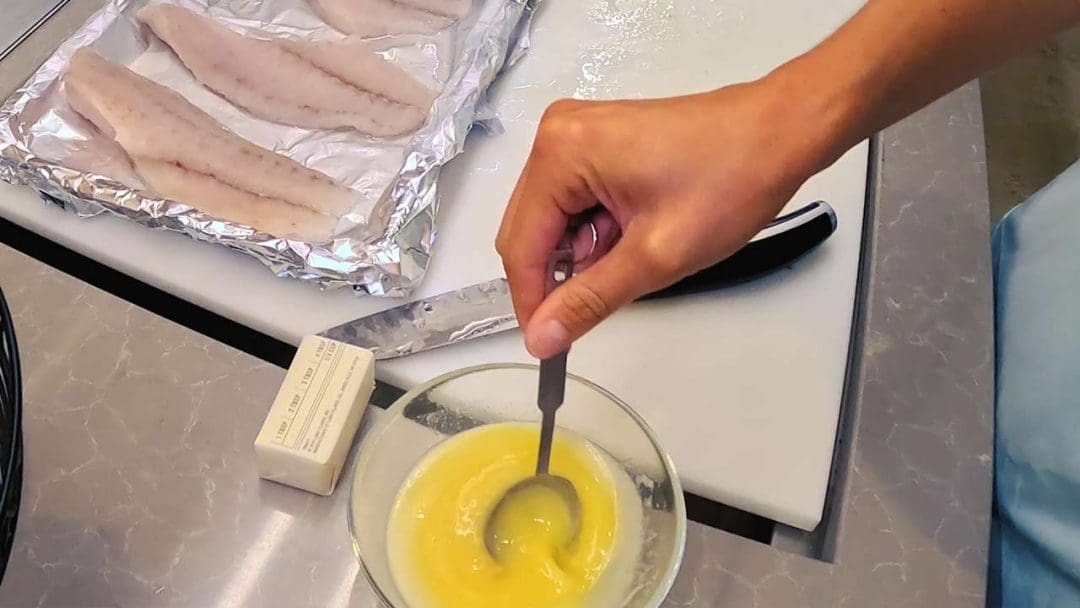
Melt the butter in a small saucepan over medium heat. Once melted, add the minced garlic and cook for 1-2 minutes, or until fragrant.
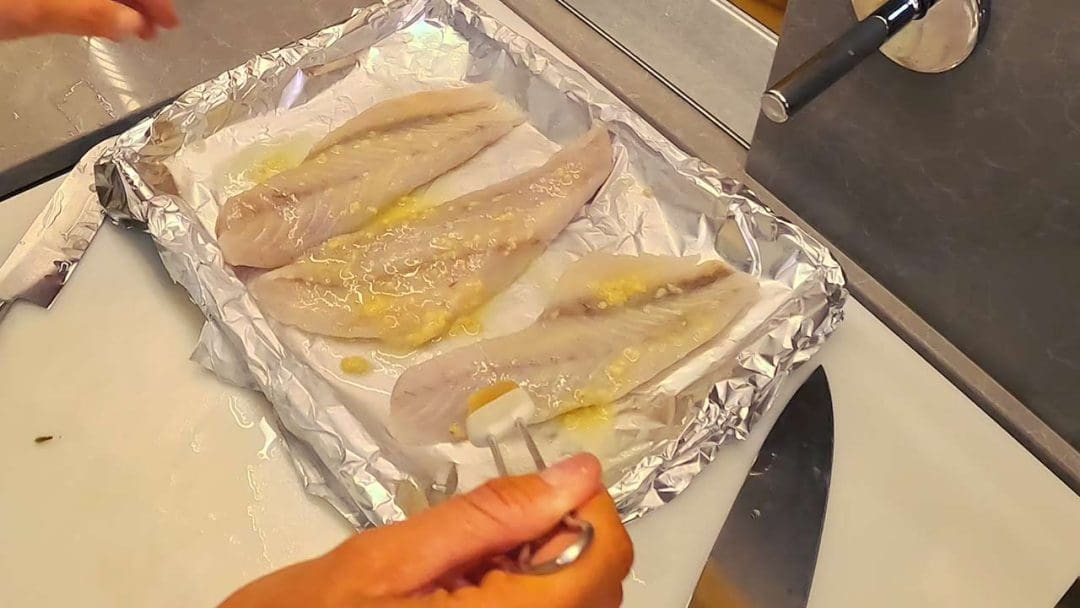
Use melted butter + garlic and generously coat prepped, cleaned and dried redfish filets.

Once covered season both sides with Prudhomme’s Redfish Magik seasoning.
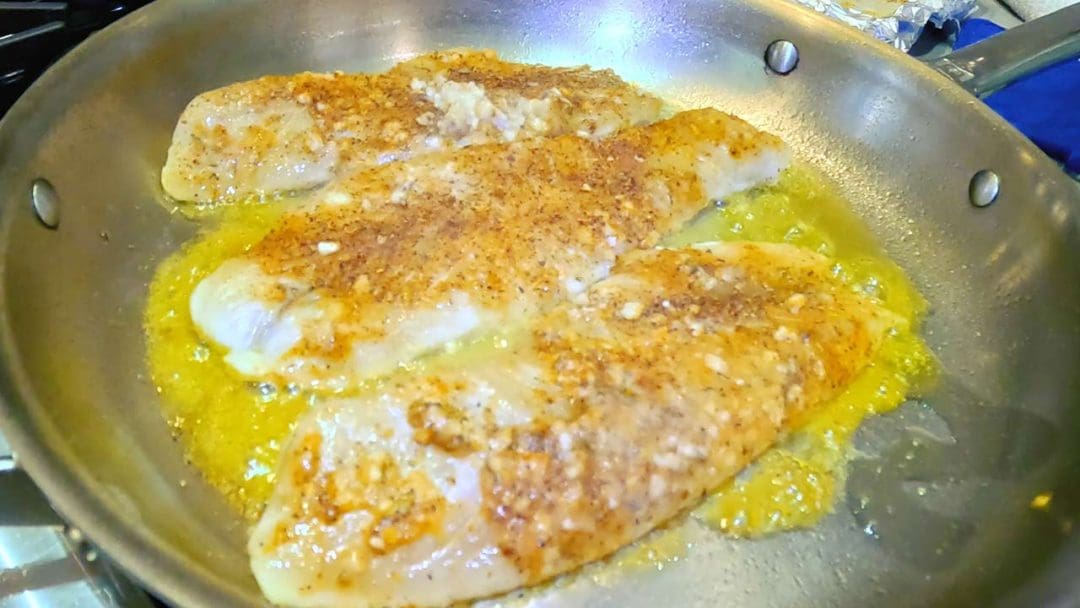
Once the skillet is hot (high heat), carefully place the seasoned redfish fillets in the skillet. Cook for 2-3 minutes on each side, or until the seasoning is blackened and the fish is cooked through.
If your fillets are thicker than 1 inch, you may need to finish cooking them in the oven. Preheat your oven to 375°F (190°C) and transfer the skillet to the oven for an additional 5-10 minutes, or until the fish is fully cooked through.

Serve immediately, drizzling the garlic butter over the top of the fish.
Cooking Safely
Disclaimer: If you’re using thicker redfish fillets, it’s important to ensure that they are fully cooked through before serving. If needed, finish cooking them in the oven to avoid serving undercooked fish.
6 Tips for Cooking Blackened Redfish
Here are some general safety warnings to keep in mind:
Cook in a well-ventilated area:
Cooking blackened fish can produce smoke, which can be harmful if inhaled. Always cook in a well-ventilated area, such as an open kitchen with an exhaust fan or outdoors.
Use protective gear:
Protect your hands, arms, and eyes by wearing oven mitts and safety glasses. Hot oil can splatter and cause burns, and spices can irritate the eyes.
Keep a fire extinguisher nearby:
Cooking on high heat can increase the risk of a fire. Always keep a fire extinguisher nearby, and know how to use it in case of an emergency.
Don’t overcrowd the pan:
Overcrowding the pan can cause the fish to steam instead of blacken, leading to a mushy texture and increased risk of burning. Cook the fish in batches if necessary, and make sure there is enough space between each piece.
Use a high-heat oil:
Choose an oil with a high smoke point, such as vegetable or canola oil, to prevent the oil from burning and smoking.
Don’t leave the pan unattended:
Stay close to the pan while cooking and don’t leave it unattended. Blackening fish requires high heat and can cook quickly, so keep a close eye on it to prevent burning or smoking.
Explore More Fishing
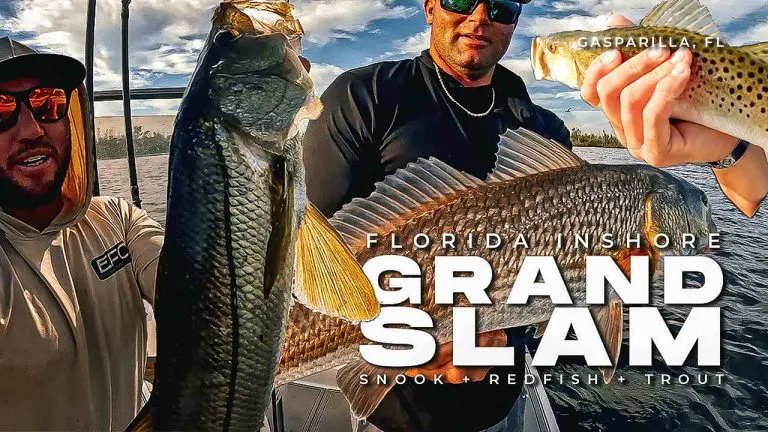
Fishing Gasparilla Florida Inshore Grand Slam Join us as we head out from Gasparilla Florida on a perfect fall…

Fishing Guide: Catching Redfish in the Gulf of Mexico Learn How to Catch Redfish (Red Drum) in the Gulf…

Cast Placement | Bank Fishing Redfish & Black Drum Positioning to Catch More Fish. Learn about effective positioning when…
How to Consistently Catch Big Redfish
Redfish are a popular and delicious gamefish, making them a prized catch for many anglers.
Catching redfish can be a lot of fun for any angler. These hard-fighting gamefish are known for their strength and explosive strikes, making for an exciting battle between angler and fish.
Watch Chasing Big Bull Redfish: Episode 16
Redfish can also be very elusive and challenging to catch, adding to the excitement of the challenge.
Whether fishing from a boat or wading in shallow waters, the thrill of feeling the tug on the line and the anticipation of reeling in a big redfish creates a rush of adrenaline for any angler.
If you’re an angler looking to consistently catch big redfish while inshore saltwater fishing, there are a few key techniques to keep in mind.
How to Consistently Catch More and Bigger Redfish
First, it’s important to focus on the right areas.
Locating the best habitats for Redfish
Look for shallow flats with grassy areas, oyster bars, or mangrove roots – these are prime redfish habitats.
Once you’ve found a good spot, use a medium-heavy to heavy action rod with a fast action tip and braided line of 30-50 pounds, paired with a spinning or baitcasting reel with a high line capacity.
Offering prime bait selection and presentation for Redfish
Redfish are attracted to live bait like shrimp, mullet, and crabs, but artificial lures such as topwater plugs and soft plastics can also be effective.
When casting, aim for the edges of grassy areas or mangrove roots, and keep a steady retrieve with occasional twitches.

Sight Fishing for Redfish
Another effective technique for catching big redfish is sight fishing. This involves looking for redfish in shallow water and casting to them directly. Polarized sunglasses are essential for spotting fish in the water. Once you’ve located a redfish, make a quiet and accurate cast with a live bait or lure. Sight fishing can be challenging but can lead to some of the most exciting and rewarding catches.
Redfish Behavior and Habitat
To locate bigger redfish, it’s important to understand their behavior and habitat preferences.
Fall Redfish Fishing
During the fall months, larger redfish can be found in shallow waters along the coastlines, particularly around structures such as oyster beds, jetties, and bridge pilings.
These structures provide shelter and a food source for redfish.
Winter Redfish Fishing
In the winter, redfish tend to move into deeper waters, but can still be found around structures such as deep channels and underwater ledges.
Spring & Summer Redfish Fishing
During the spring and summer months, larger redfish can be found in the bays and estuaries, particularly around grass flats and marshy areas.
Redfish Structure and Habitat
In addition to understanding the time of year, it’s also important to pay attention to the structure of the water.
Big redfish prefer underwater structures that provide shelter and food, such as oyster beds, jetties, bridge pilings, submerged logs, and rock formations.
They also tend to congregate around areas with a change in water depth or currents, such as channels or drop-offs. Grass flats and marshy areas can be prime spots to find larger redfish during the spring and summer months.
By targeting these structures, anglers can increase their chances of catching a trophy redfish.
Watch Fishing Grass Flats for Redfish: Episode 17
In general, larger redfish tend to prefer areas with a mix of structure and open water, as these areas provide a variety of hunting opportunities and cover from predators.
When targeting larger redfish, it’s important to use the right gear and techniques.
Redfish Rod Types
A medium-heavy to heavy action rod with a fast action tip paired with a spinning or baitcasting reel is recommended, with braided or monofilament line of 15-30 pounds and leader of 20-30-pound fluorocarbon.
Best Redfish Baits & Lures
Redfish are attracted to live baits such as shrimp, mullet, and crabs, as well as artificial lures such as soft plastics, spoons, and topwater plugs.
By understanding the behavior and habitat preferences of larger redfish, and using the right gear and techniques, you can increase your chances of landing a trophy catch.
Best time of day for catching Redfish
It’s important to pay attention to the tides and time of day. Redfish are most active during the falling tide and low light conditions, such as dawn and dusk.
During these times, redfish are more likely to be found feeding and are therefore more likely to take your bait.
By keeping these factors in mind and using the right gear and techniques, you can consistently catch big redfish while inshore saltwater fishing.
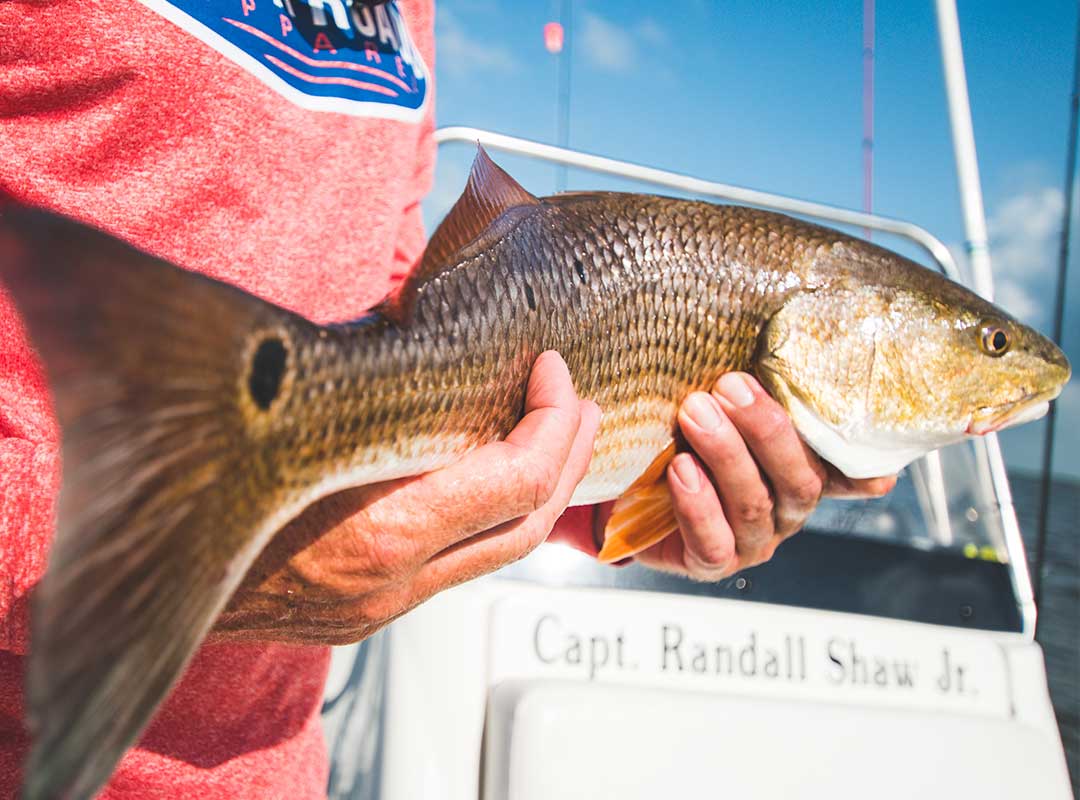
Reach out to local Redfish fishing guides
Talking with local guides can be also be a valuable resource for anyone looking to time the feeding patterns of local redfish. Experienced guides should have an intimate knowledge of local waters and the behavior of Redfish within them.
They can offer insight into the best times of day, tides, and locations to catch redfish.
By understanding the feeding patterns of redfish, anglers can increase their chances of success and have a more productive and enjoyable fishing experience.
Local guides can additionally offer tips on the best gear and techniques to use for redfish fishing in their area.
The knowledge gained from talking with local guides can be the difference between a successful fishing trip and a disappointing one.
Moon Cycles for Catching Redfish
If you’re an angler who favors moon cycles to plan your fishing trip, our table provides a helpful guide to the best times to fish for redfish based on the moon phase.
Knowing the optimal fishing times can greatly increase your chances of landing a big catch, and our table makes it easy to plan your next redfish fishing adventure.
| Moon Phase | Best Fishing Times for Redfish |
|---|---|
| New Moon | Early morning and late afternoon/evening during rising tides |
| Waxing Crescent | Early morning and late afternoon/evening during incoming tides |
| First Quarter | Mid-morning to mid-afternoon during high tides |
| Waxing Gibbous | Early morning and late afternoon/evening during incoming tides |
| Full Moon | Late afternoon/evening during rising tides |
| Waning Gibbous | Early morning and late afternoon/evening during outgoing tides |
| Last Quarter | Mid-morning to mid-afternoon during low tides |
| Waning Crescent | Early morning and late afternoon/evening during outgoing tides |
Whether you prefer early morning or late afternoon/evening fishing, incoming or outgoing tides, or high or low tides, our table has you covered. Keep in mind that fishing times can vary based on location, weather conditions, and other factors, and this is intended simply as a useful starting point for maximizing your chances of success catching Redfish.
With some additional knowledge, and a little bit of luck, you’ll be well on your way to experiencing the excitement and thrill of catching more redfish.
The excitement of catching redfish is not just in the catch itself but also in the memories made and stories shared about the experience.

Fishing Gasparilla Florida Inshore Grand Slam Join us as we head out from Gasparilla Florida on a perfect fall…

Fishing Guide: Catching Redfish in the Gulf of Mexico Learn How to Catch Redfish (Red Drum) in the Gulf…

Cast Placement | Bank Fishing Redfish & Black Drum Positioning to Catch More Fish. Learn about effective positioning when…
Gulf of Mexico Inshore Fishing
Discover the Gulf Coast: Inshore Saltwater Fishing Species
Are you an avid fisherman looking for your next big catch? Look no further than inshore saltwater fishing, where you can find a variety of popular and reel-screaming fish species. From redfish to tarpon, speckled trout to flounder, there’s something for every angler.
Read on to learn more about these fish, their habitats and behaviors, and when and where to find them.
Gulf Coast Redfish:
The Majestic and Feisty Catch of Inshore Waters
Redfish are a favorite among inshore anglers for their beautiful copper color and aggressive behavior. Found along the Gulf Coast and Atlantic Ocean, they prefer shallow waters and can be caught year-round. They are known for their strength and will put up a good fight, making them a thrill to catch.
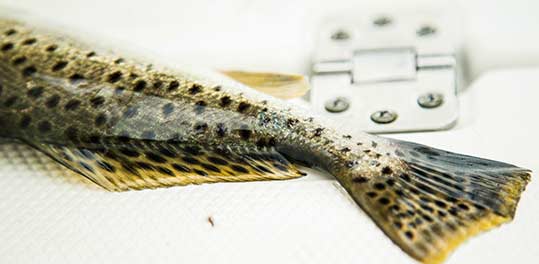
Gulf Coast Speckled Trout:
The Delicate and Delicious Prize of Inshore Fishing
Speckled trout are known for their delicate flavor and are a popular catch among inshore anglers. Found in coastal waters from Texas to Florida, they prefer shallow waters and can be caught year-round. They are known for their elusive behavior, making them a challenge to catch, but the reward is worth it.
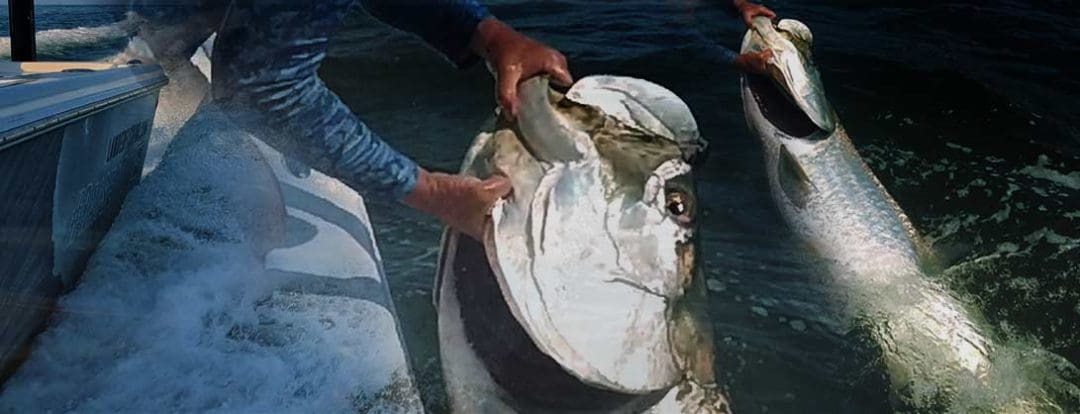
Gulf Coast Tarpon:
The King of Inshore Saltwater Fishing
Tarpon are the ultimate prize for inshore anglers, known for their sheer size and acrobatic jumps. Found along the Gulf Coast and Atlantic Ocean, they prefer warm waters and can be caught during the summer months. They are known for their unpredictable behavior and are a true test of an angler’s skill.
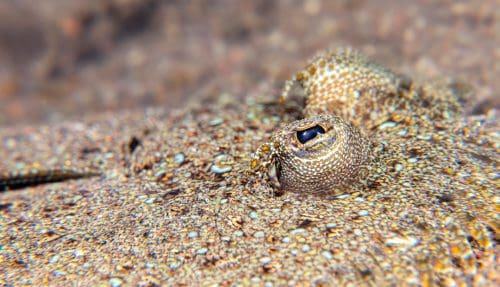
Gulf Coast Flounder:
The Camouflaged and Tasty Catch of Inshore Waters
Flounder are a popular catch among inshore anglers for their delicate and delicious flavor. Found along the Gulf Coast and Atlantic Ocean, they prefer shallow waters and can be caught year-round. They are known for their unique camouflaging abilities, making them a challenge to spot and catch.
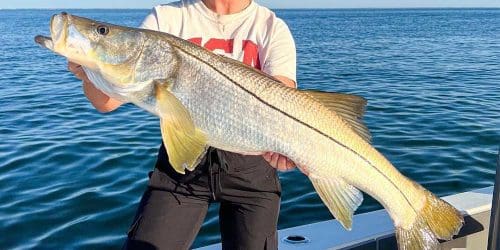
Gulf Coast Snook:
The Elusive and Acrobatic Catch of Inshore Waters
Snook are a prized catch for their acrobatic jumps and sleek body. Found in the coastal waters of Florida and the Gulf of Mexico, they prefer warmer waters and can be caught year-round. They are known for their elusive behavior, making them a challenging catch for even the most experienced angler.
Commonly Caught Fish in The Gulf of Mexico
The Gulf of Mexico is home to a wide variety of fish species, and the types of fish that are commonly caught can vary depending on the season, location, and fishing techniques used. However, some of the most common fish species that are reported to be caught in the Gulf of Mexico include:
Red Snapper
A popular game fish with a bright red color and a delicious flavor.
Grouper
A bottom-dwelling fish that can grow quite large, with some species weighing up to 800 pounds.
Mahi Mahi
Also known as dorado or dolphin fish, this species is known for its vibrant colors and acrobatic jumps.
Tuna
Several species of tuna can be found in the Gulf of Mexico, including yellowfin, blackfin, and bluefin tuna.
King Mackerel
A fast-swimming fish that can be caught using a variety of techniques, including trolling and live bait fishing.
Cobia
A large fish that can be found near structures like reefs and oil rigs, and is prized for its firm, white flesh.
Amberjack
A strong and aggressive fish that can be caught using heavy tackle and live bait.
Tarpon
A challenging game fish that is known for its impressive size and acrobatic jumps.
Gulf Coast Inshore Saltwater Fish:
Understanding Gulf Fish Species: Habitat and Behaviors
Understanding the habitat and behaviors of inshore fish is crucial to finding and catching them. Most inshore fish prefer shallow waters with plenty of cover, such as grass beds, oyster bars, and mangrove trees. They are also affected by water temperature, salinity, and tides. Learning these patterns and behaviors can help you target and catch the fish you’re after.
Seasonal Patterns and Migrations in the Gulf of Mexico:
When and Where to Find Inshore Fish
Knowing the seasonal patterns and migrations of inshore fish can greatly increase your chances of catching them. Many inshore fish migrate to different areas based on the time of year, weather, and water conditions.
For example, tarpon can be found in warmer waters during the summer months, while redfish can be caught year-round in shallow waters. Understanding these patterns can help you plan your fishing trips and catch more fish.
Inshore saltwater fishing offers a variety of popular and fascinating fish species for anglers of all levels. Understanding their habitats, behaviors, and seasonal patterns can greatly increase your chances of catching them.
So grab your gear and head out to the inshore waters for your next big catch!
Get Hooked Up,
Subscribe to Landed Fishing
Our expert guides share tips and techniques, showcasing thrilling catches of popular fish species like redfish, snook, and tarpon.
Enjoy high-quality videos capturing the excitement of the catch and challenges in the Gulf of Mexico.
Sight Fishing Redfish
Sight Fishing Redfish in the Gulf of Mexico
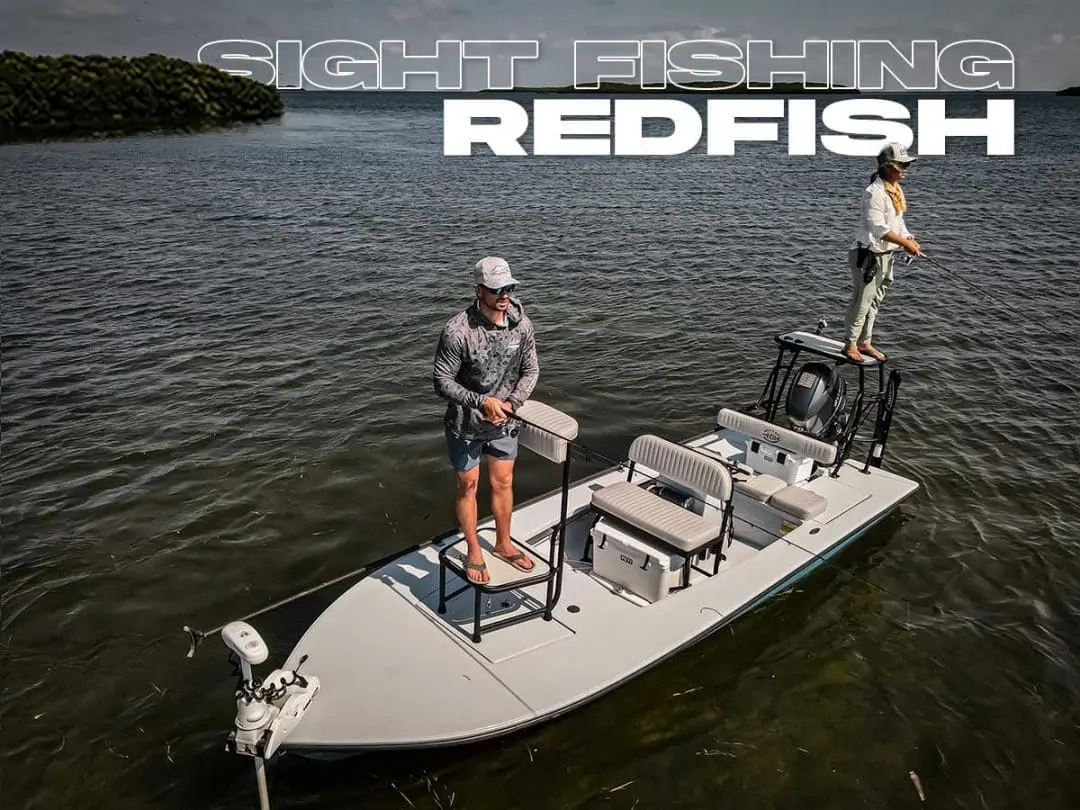
It involves stalking Red fish in shallow waters, making a perfect cast, and experiencing their explosive strikes and acrobatic fights. It’s a memorable experience for both experienced and novice anglers alike.
Redfish (Saltwater Inshore Fish)

Redfish, also known as red drum, are a popular game fish for inshore anglers. They are known for their hard fights and can be caught using a variety of techniques.
Redfish are found in coastal waters and estuaries along the Atlantic and Gulf coasts of the United States.
They are known for their bronze-red coloration and distinctive black spot near the tail. Redfish are bottom feeders that prefer shallow waters with structures such as oyster beds, grass flats, and docks.
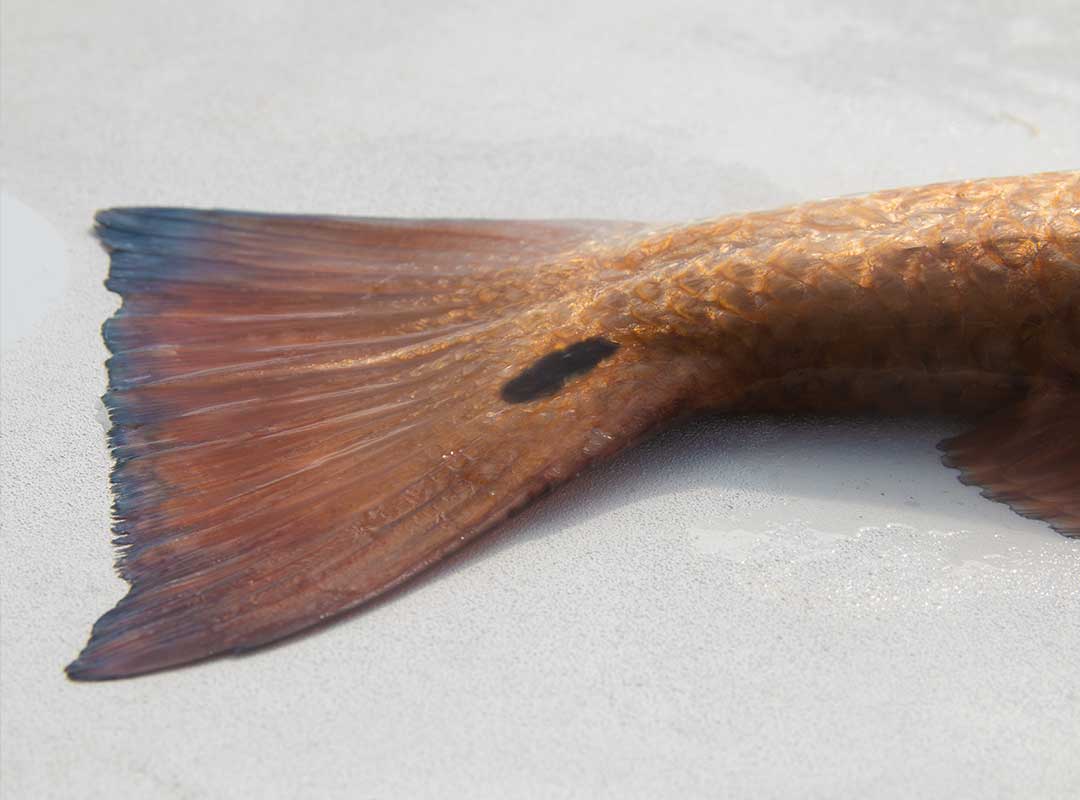
Pro Tips for Sight Fishing Redfish
Sight fishing for redfish can be challenging, exciting and very rewarding. By following these a few simple tips, you can increase your chances of finding and catching this sought-after game fish.
Move slowly and quietly to avoid spooking the fish, and look for tail or fining to indicate their location. When casting, aim ahead of the fish’s path, and vary your retrieve speed and technique until you find what works.
Redfish can be picky eaters, so experimenting with different presentations can also increase your chances of success.
Sight Fishing Red Drum
Optimal fishing times for redfish are early morning before the sun warms up the shallows and late afternoon when fishing in deeper water structures such as jetties, wrecks, and bridges.
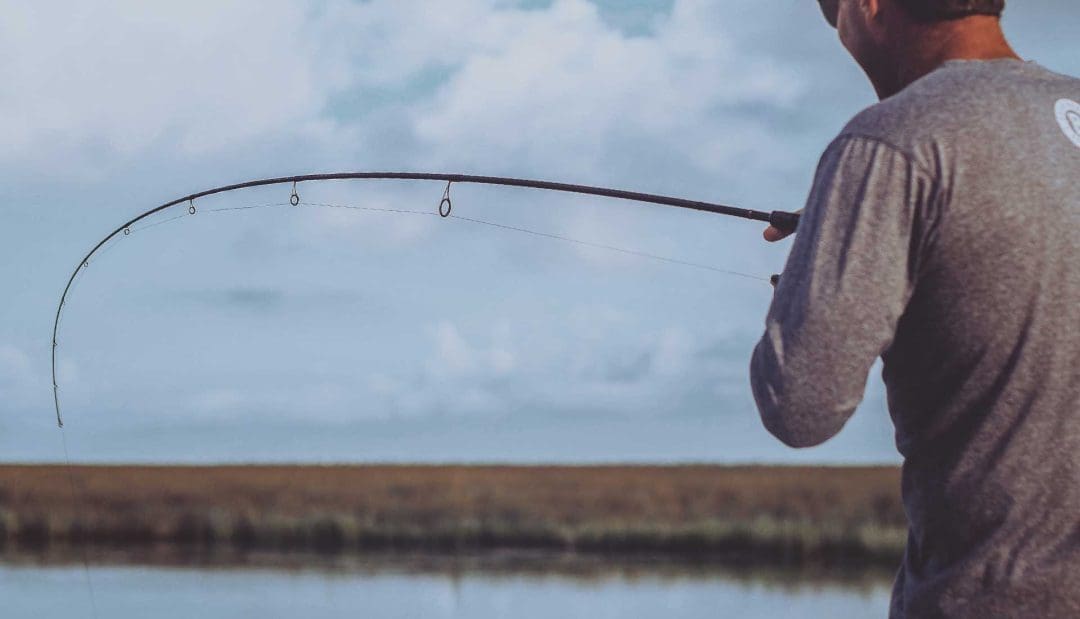
Adjust your casts to target the area surrounding or in front of the school of fish.
Avoid casting directly into the center of the school
Late summer and mid-fall, particularly in grassy flats, offer the best season for targeting redfish.
October is considered the prime month for catching redfish as the water begins to cool.
Effective lures for redfish are 3 to 5-inch white paddle tails paired with red jig heads weighing between 1/8 and 1/2 ounce, or slow-moving weedless gold spoons near the bottom of the water column.
The Best Spots to Sight Fish for Redfish
US coastal states along the Gulf of Mexico are well-known for their exceptional sight fishing opportunities for Redfish.
To locate the best spots for targeting this species, factors such as water depth and structure must be taken into consideration.
Shallow Water Habitats for Redfish
In Louisiana, the marshes and bayous provide ample shallow-water habitats that Redfish thrive in, making it an ideal location for sight fishing.
Texas, on the other hand, boasts a variety of structures including jetties, flats, and marshes that provide suitable habitats for Redfish.
Redfish in Flats and Inlets
The Florida Panhandle is another area where sight fishing for Redfish is popular, particularly in the shallow flats and inlets that can be found along the coast.
Finding the Best Redfish Structure
When searching for the best spots for sight fishing for Redfish in the Gulf of Mexico, it’s important to look for areas with diverse structures such as oyster beds, mangroves, and grassy flats. These structures serve as natural habitats for Redfish and can provide opportunities to spot and target these fish.
Oyster Beds, Mangroves and Grass Flats are prime locations to Sight Fish for Redfish
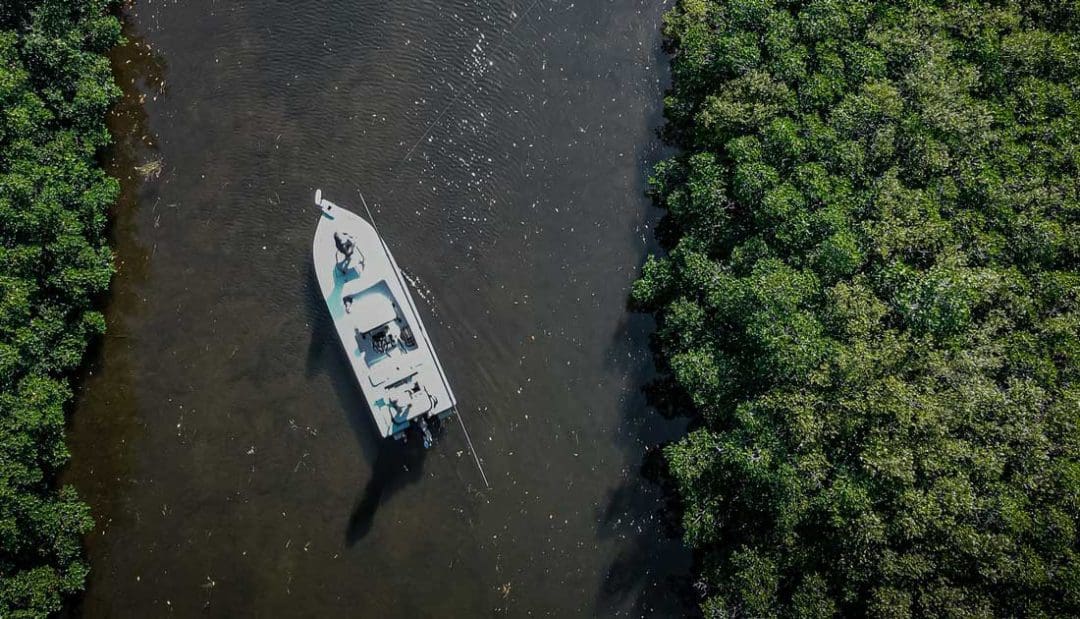
Fish Channels, Drop Offs and Other Changes in Water Depth for Redfish
Keep in mind, Redfish tend to congregate in areas with changes in water depth, such as channels or drop-offs, making these areas prime locations for sight fishing.
The Gulf of Mexico offers a range of suitable habitats and structures for sight fishing for Redfish, and exploring different areas can lead to discovering new and exciting spots.
Finding redfish can be challenging for some anglers, especially for those new to inshore fishing.
Maximize Your Redfish Catch with Expert Tips from Landed Fishing!
Check out the channel and subscribe for more!
Redfish During Tides
Predatory fish such as redfish tend to be more active and easier to locate during tidal movements, making it an optimal time for sight fishing.
High Tide Redfish:
Grass flats are shallow areas with underwater grass beds that provide cover and food for various marine species, including redfish.
During high tide, the water level rises, and the grass flats become flooded, creating an ideal feeding ground for redfish.
These fish will move into these areas to feed on baitfish and crustaceans, such as shrimp and crabs, which are abundant in the grass beds.
Low Tide Redfish:
During low tide, they will move to deeper waters such as channels and holes. Additionally, redfish can be found in estuaries, bays, and lagoons, especially those with a mix of fresh and saltwater.
It is important to research the specific location you plan to fish in and take note of the tides and structure present to increase your chances of finding and catching redfish.
Sight Fishing for Redfish with Artificial Lures
Soft plastic baits: These versatile lures can imitate a variety of prey and can be rigged to mimic shrimp, crabs, or small baitfish. Popular options include the Berkley Gulp! Saltwater Shrimp and Z-Man Trout Trick.
Topwater lures: These lures create a commotion on the surface of the water that can entice redfish to strike. The Heddon Super Spook Jr. and the Rapala Skitter Walk are popular choices.
Jigs: Jigs are effective for sight fishing because they allow you to control the depth and speed of your lure. The Strike King Saltwater Flats Jighead and Z-Man Trout Eye Jighead are popular options.
Spoons: These lures have a distinctive wobbling action that can attract redfish from a distance. The Johnson Silver Minnow and the Capt. Mike’s Spoon are popular choices.
Sight fishing for redfish with artificial lures is popular for targeting specific fish and mimicking natural prey.
Sight Fishing for Redfish with Live Bait
Shrimp: Live shrimp are a natural prey for redfish and can be fished on a jighead or Carolina rig.
Crabs: Blue crabs or fiddler crabs can be effective when fishing in shallow water and around oyster beds.
Shad: Also known as pogies, these baitfish are popular for live bait fishing and can be fished on a Carolina rig or under a popping cork.
Mullet: Finger mullet or live mullet can be fished on a Carolina rig or free-lined.
Pinfish: These small baitfish can be fished on a jighead or Carolina rig and are especially effective when fishing around structure such as docks or mangroves.
If you prefer to use live bait when sight fishing for redfish, here are the top 5 choices:
When sight fishing for redfish with artificial lures or live bait, it’s important to match your presentation to the conditions and the behavior of the fish.

Experiment with different lures and techniques until you find what works best for you.
Where to Catch Gulf Coast Redfish
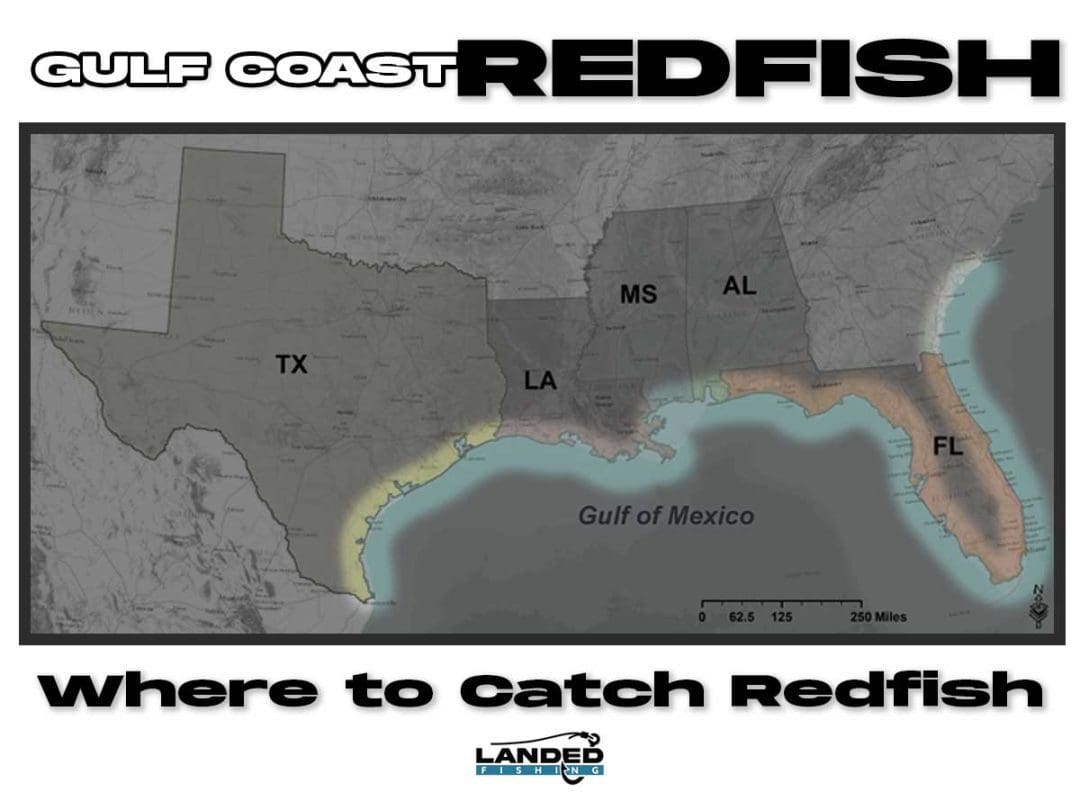
Redfish Bag Limits by US State
| State | Bag Limit | Link to Fish and Wildlife Website |
|---|---|---|
| Alabama | 3 fish per person/day | https://www.outdooralabama.com/fishing/saltwater-fishing |
| Florida | 1 fish per person/day | https://myfwc.com/fishing/saltwater/recreational/red-drum/ |
| Georgia | 5 fish per person/day | https://gadnr.org/fishing-regulations |
| Louisiana | 5 fish per person/day | https://www.wlf.louisiana.gov/fishing/saltwater-rules-regulations |
| Mississippi | 3 fish per person/day | https://www.mdwfp.com/fishing-boating/saltwater-fishing/regulations/ |
| North Carolina | 1 fish per person/day | https://www.ncwildlife.org/Fishing/Laws-Safety/Saltwater-Fishing |
| South Carolina | 3 fish per person/day | https://www.dnr.sc.gov/lawsregs/saltwaterregs.html |
| Texas | 3 fish per person/day | https://tpwd.texas.gov/regulations/outdoor-annual/fishing/ |
| Virginia | 3 fish per person/day | https://www.mrc.virginia.gov/regulations/swrecfishingrules.shtm |
It’s important to note that bag limits can vary by season, size, and location, so be sure to check the specific regulations for the area you plan to fish.
Best time of Day for Sight Fishing Redfish
Early Morning Redfish
Redfish tend to be more active and feed actively during the first few hours after sunrise.
Late Afternoon Redfish
The period leading up to sunset is another prime time for redfish activity, as the water begins to cool down and baitfish become more active.
Midday Redfish
During hot midday periods, redfish may retreat to deeper water and become less active. However, this can vary depending on the season and weather conditions.
Night Fishing
Nighttime can be a productive time for fishing, as redfish may move into shallower water to feed under the cover of darkness.
The best time of day for sight fishing for redfish can vary based on location, season, and weather. Being flexible and adapting your approach is key.
Fishing Grass Flats for Redfish
Watch Episode 17:
What to Look for When Sight Fishing Redfish
Look for Structure:
Redfish are often found around structure such as docks, mangroves, and oyster beds. These structures provide cover and food for redfish, making them a prime location for finding them.
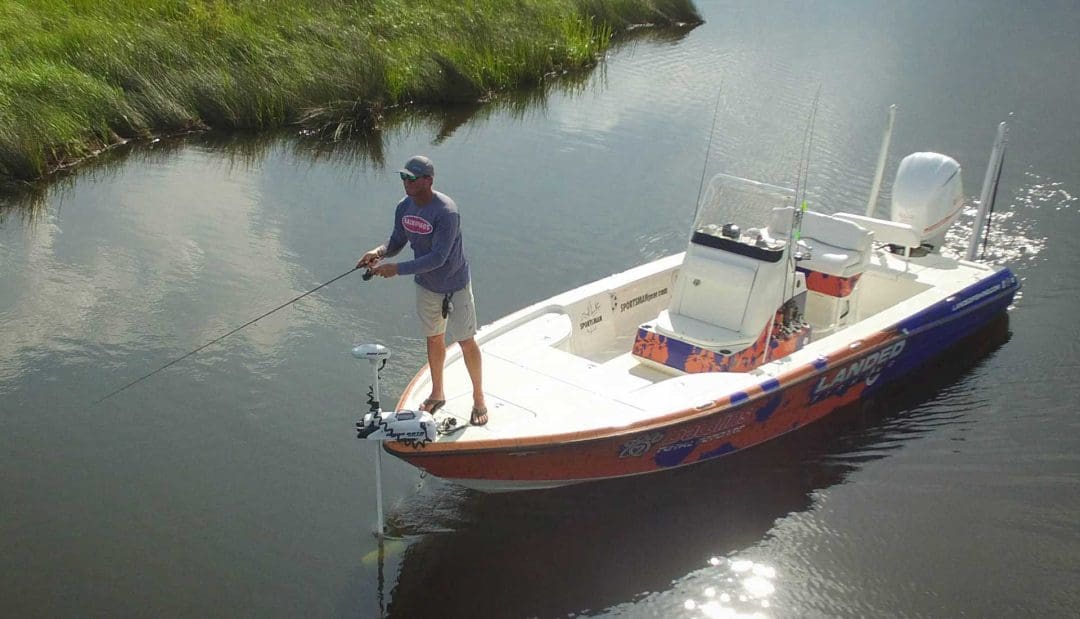
Fun Redfish Fact:
Redfish “finning” is when the fish floats with its dorsal and tail fins above water. Each redfish has a unique signature on its tail which can be used to identify individual fish.
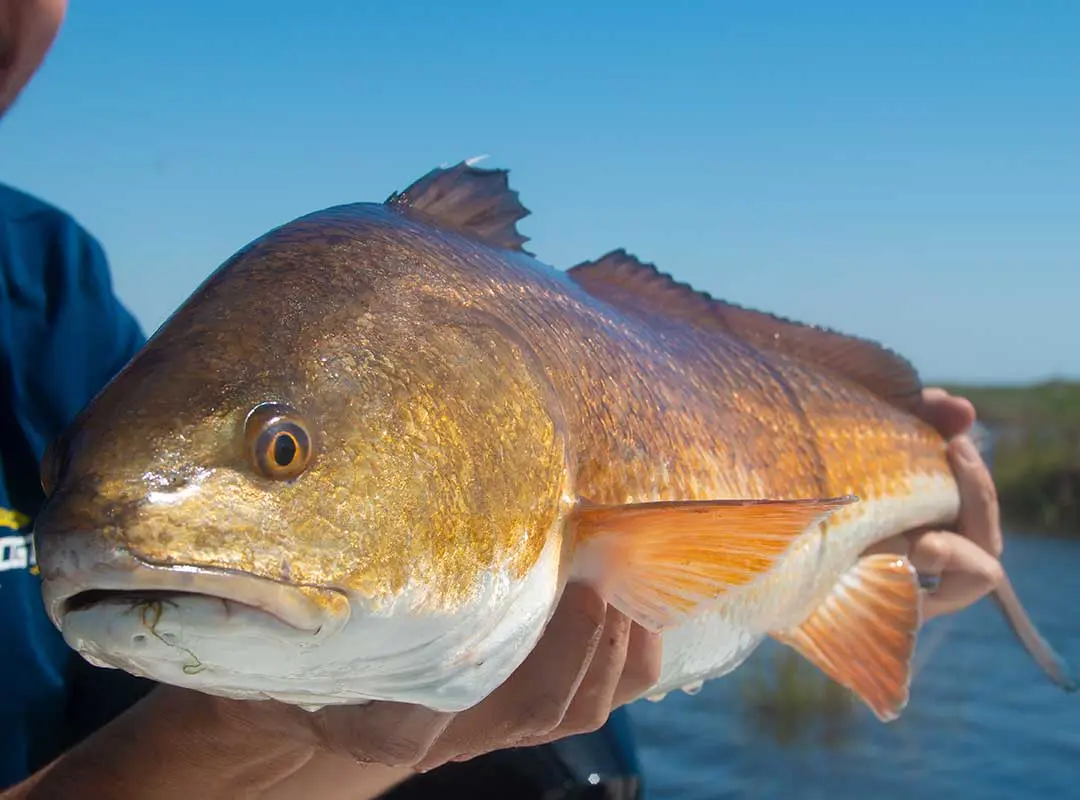
When sight fishing for redfish, it’s important to aim your casts around or in front of the school of fish instead of casting directly in the middle of the school. This avoids spooking the fish and disrupting the school, increasing your chances of success.

How to Sight Fish and Catch Redfish
1.) Check the Tides:
Redfish are known to feed during incoming and outgoing tides.
During the incoming tide, they will move into shallow waters to feed, and during the outgoing tide, they will move to deeper waters. Knowing the tide schedule can help you plan your fishing trip accordingly.
2.) Watch for Baitfish:
Redfish feed on small baitfish such as mullet and pinfish.
Keep an eye out for baitfish activity, such as jumping or fleeing, as this can indicate the presence of redfish in the area.
3.) Look for Mud Boils:
Redfish are known to create mud boils when feeding in shallow waters.
These mud boils are created by their tails stirring up the bottom sediment, creating a visible disturbance on the surface.
4.) Follow the Birds:
Birds such as seagulls and pelicans can help you locate redfish.
These birds often feed on the same baitfish as redfish, so if you see a flock of birds diving into the water, it’s a good sign that there are redfish in the area.

5.) Proper Eyewear
To better sight fish for redfish, it is important to use polarized sunglasses to see through the water’s surface glare and spot redfish.
Sight fishing for redfish is a thrilling and exciting experience that requires precision and patience.
A key to successful sight fishing is precision casting.
Redfish require a precise presentation, and the angler must make a perfect cast to avoid spooking the fish. The angler must be ready to strike as soon as the redfish takes the bait, as they put up a fight that can last for several minutes. Landing a trophy redfish is the ultimate reward for a successful sight fishing expedition.
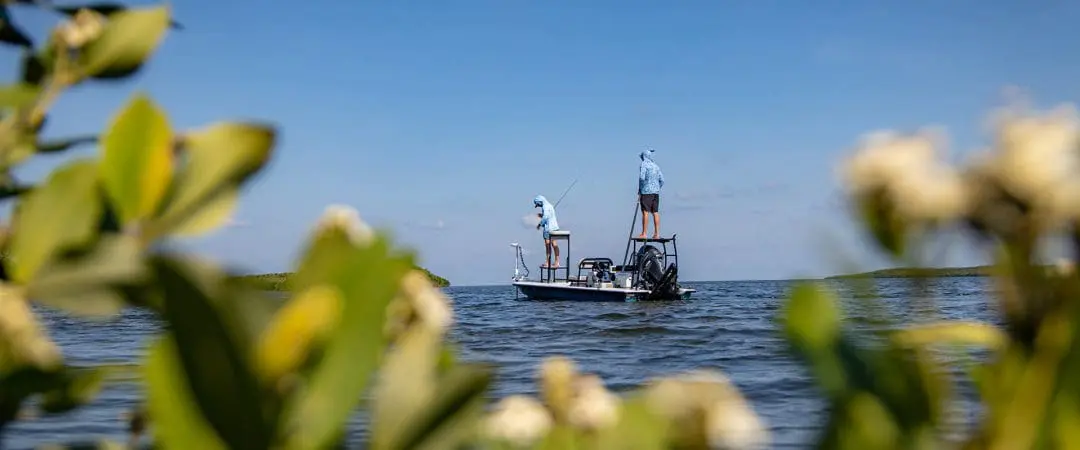
Sight fishing for redfish is a lot of fun
It involves spotting the redfish in the shallow waters and making a perfect cast to lure them in. Sight fishing requires keen observation and a bit of luck, as redfish are elusive and spook easily.
The adrenaline rush that comes with catching a redfish combined with the screaming of drag ripping out is what makes sight fishing Redfish, such an exciting sport.
Sight fishing for Redfish continues to gain popularity
Sight fishing for redfish is a popular sport in Louisiana as well as the Gulf Coast, where anglers can find plenty of redfish in the shallow waters. With the right gear and technique, anglers can experience the thrill of reeling in a big redfish just like in the Louisiana marshes.
Sight fishing for redfish is an exciting and challenging sport that requires patience, skill, and a bit of luck.

Improving you Chances of Catching Redfish
The best live baits for redfish include shrimp, crabs, and small fish such as mullet or menhaden, while lures such as soft plastics, topwater plugs, and spoons are also effective. Successful redfish fishing requires knowledge of their feeding habits, habitat preferences, and tidal movements.
Spotting the redfish:
The thrill of finding a redfish in the shallow waters and anticipating the catch.
Visual hunt:
Sight fishing is all about visually spotting the fish and making a perfect cast.
Catching Redfish:
The ultimate reward is landing a trophy redfish and the satisfaction of a successful sight fishing expedition.
Adrenaline rush:
As soon as the redfish takes the bait, the adrenaline starts pumping, making for an exciting fight.
Precision casting:
Making a perfect cast is crucial, as the redfish spook easily and require a precise presentation.

Redfish Roundup: Louisiana’s Year-Round Fishery
Louisiana is known for its excellent redfish fishery, with anglers from around the world traveling to the state to catch these hard-fighting game fish. Redfish can be caught in Louisiana’s waters year-round, but there are certain seasons and conditions that are particularly productive for targeting them.
Reeling in the Action: Targeting Louisiana Redfish by Season
Spring (March-May):
During the spring, redfish can be found in the marshes and backwaters of Louisiana, where they are feeding on shrimp and other small baitfish. Anglers often target them with artificial lures or live bait, casting around grass beds and other structure.
As water temperatures rise, redfish become more active and aggressive, making for exciting fishing action.
Summer (June-August):
Summer is a great time to target redfish in Louisiana’s deeper waters, such as near offshore rigs and other structures.
The warmer water temperatures cause redfish to move out of the shallows and into deeper water, where they are more easily caught using jigs, soft plastics, and live bait.
Fall (September-November):
As the weather cools down in the fall, redfish begin to move back into the shallows in search of food. This makes them more accessible to anglers, who can catch them using topwater lures, spinnerbaits, and other surface baits.
Fall is also a great time to target larger redfish, which are often found in schools and can be caught using live bait or soft plastics.
Winter (December-February):
While winter can be a challenging time to target redfish in Louisiana, it is still possible to catch them using a variety of techniques. Anglers often target deep holes and channels, where redfish are seeking warmer water temperatures.
Live bait such as shrimp or mullet can be effective, as well as artificial lures like jigs and spoons.
From Spring to Winter: Louisiana’s Versatile Redfish Fishery
Louisiana’s redfish fishery provides year-round opportunities for anglers to catch these prized game fish. Whether targeting them in the shallow marshes or the deeper waters offshore, there is always a chance to hook into a big Louisiana redfish.
A Few More Tips for Catching Redfish
6.) Move Slowly and Quietly:
Redfish have excellent hearing and can be spooked by loud noises or sudden movements. Move your boat slowly and quietly to avoid scaring them away.
7.) Look for Tail or Fining:
Redfish will often swim with their backs and tails exposed when feeding in shallow waters. Look for their tails or fins sticking out of the water, indicating their location.
8.) Cast Ahead of the Fish:
When sight fishing for redfish, cast your lure or bait ahead of the fish’s path, giving them time to notice and take the bait.
9.) Vary Your Retrieve:
Redfish can be picky eaters, so vary your retrieve speed and technique until you find what works. Some redfish prefer a fast retrieve, while others prefer a slower, more natural presentation.
Weather Conditions: Sight Fishing Redfish
Sight fishing Redfish in different weather conditions: Low wind, clear and sunny days are best and makes it easier to spot fish. Cloudy or windy conditions can make it harder to see fish movement and reduce casting accuracy.
Redfish tend to be more active during early mornings and late afternoons, and may retreat to deeper water during hot midday periods. Adapting your approach to the weather conditions can increase your chances of success.
Safety: As with all fishing activities, weather should be monitored before your fishing trip
Want to try some action packed redfish fishing yourself with world class charters?
Gulf Coast Inshore Fishing Trips & Charters
Sight Fishing Redfish FAQs
Catch More Redfish: Popping Corks on Falling Tide
Are you tired of coming home empty-handed after a day of redfish fishing? Look no further than this must-watch video on catching more redfish using popping corks on a falling tide!
Captain Randall Shaw Jr takes you through every step of the process, from selecting the perfect popping cork. You’ll learn how to cast effectively and position yourself for optimal success, all while taking advantage of the natural conditions of a falling tide.
Join us in this thrilling video as we explore the art of catching redfish using popping corks on a falling tide. With our expert tips and techniques, you’ll learn how to select the right equipment, rig your setup, and use the perfect bait to entice the biggest redfish in the water.
Step-by-step through the process, explaining the nuances of popping corks and how they can increase your chances of catching big redfish on falling tides.
Whether you’re a seasoned angler or just getting started, this video is a must-watch for anyone looking to master the art of catching redfish using popping corks on a falling tide. So, grab your gear and get ready to reel in some big catches with our expert guidance!
Redfish strikes and expert analysis of each catch, for any angler looking to up their redfish game. Whether you’re a seasoned pro or a novice just starting out, you won’t want to miss catching more redfish.
So why wait? Grab your gear and get ready to reel in the big one with this game-changing video on catching more redfish using popping corks on a falling tide!

